 Germany (1902-04)
Germany (1902-04)SMS Bremen, Hamburg, Berlin, Lübeck, München, Leipzig, Dantzig
WW1 German Cruisers
Irene class | SMS Gefion | SMS Hela | SMS Kaiserin Augusta | Victoria Louise class | Prinz Adalbert class | SMS Prinz Heinrich | SMS Fürst Bismarck | Roon class | Scharnhorst class | SMS BlücherBussard class | Gazelle class | Bremen class | Kolberg class | Königsberg class | Nautilus class | Magdeburg class | Dresden class | Graudenz class | Karlsruhe class | Pillau class | Wiesbaden class | Karlsruhe class | Brummer class | Königsberg ii class | Cöln class
The Bremen class: More than just improved Gazelles
After the satisfactory deign of the Gazelle class (IV class, 11 ships 1898-1902) it was decided to repeat the type with many improvements: Larger to house a better powerplant, faster, better armed, and better armored. They were also the first cruiser named after cities, which became standard from this point, rather than mythological figures.
The Bremen class comprised seven light cruisers, all built in the early 1900s as SMS Bremen, Hamburg, Berlin, Lübeck, München, Leipzig, and Danzig. Like the previous Gazelles, their main battery comprised ten 10.5 cm SK L/40 guns plus two torpedo tubes. These ships served in a variety of roles from colonial cruiser to fleet scout and training ship in peacetime. Bremen and Leipzig served in the American and Asian stationsthe others alternating betwe the Baltic and North sea, training with the High Seas Fleet. In August 1914, Leipzig was in the Pacific (East Asia Squadron), fought at the Battle of Coronel and sink later at the Battle of the Falkland Islands. SMS Bremen hit a Russian mine in the baltic, December 1915, the other five surviving, seized by Britain as war prizes, sold for scrapping except Hamburg and Berlin, which ended as training cruisers of the new Reichsmarine, then barracks ships until 1944, Hamburg sunk by British bombers, Berlin scuttled after the war with Chemical weapons onboard.
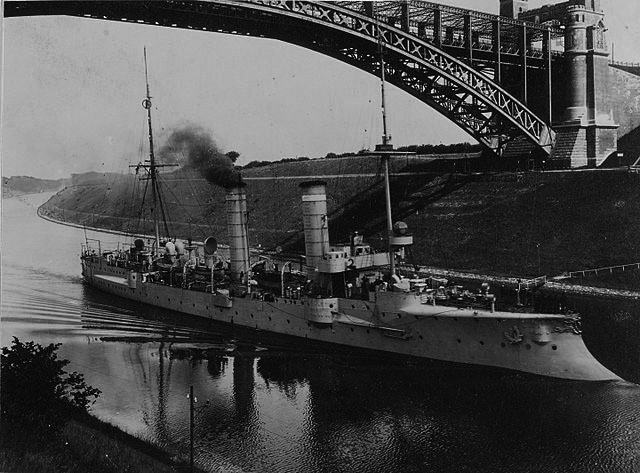
SMS Medusa passing the Kiel canal, from the previous Gazelle class.
Design development 1898-1900
The German parliament’s 1898 Naval Law authorized construction of no less than thirty new light cruisers, to be fufilled by 1904 (do in six years). This implied two cruisers per fiscal year. An amendment passed in 1900 increased it to three to keep up the pace as new programs came in. That year, Admiral Alfred von Tirpitz, the new head of the Reichsmarineamt or Imperial Naval Office, favoring home waters to foreign stations.
Since the Gazelle-class already filled the requirements for the first ten 1898 Naval Law ships, most affected to foreign stations, the remainder were to be redesigned as the Bremen class mostly to serve in home waters, but still with a dual role of peacetime station cruisers and training vessels, but in wartime, fleet scouts.
Many improvements were to be ported over the Gazelle class, in size and speed. The requirement for “fleet scout” meant a greater speed, in turn traduced into more internal space for a more powerful propulsion system. With more boilers, a third funnel appeared, while to stand in combat against Royal Navy light cruisers, the armor deck was massively thickened. While in 1900 design work progressed, Tirpiz, informed of development on new German turbines to be ready by 1901 instructed the construction department to fitting one in the newly built cruisers.
He also wanted to compare performances this way between the Gazelle’s triple-expansion steam engines and the Bremen class, and to have on the longer term, an all-turbine powered home water fleet, as well as comparing between turbine manufacturers with same-class vessels. The Kaiser approved his decision in the end, but as design work was finished and construction was already underwat, limited on the fourth ship of the class, SMS Lübeck. t was approved on 20 January 1903.
The Bremen class marked a change not only in naming conventions, greeting old Hanseatic League cities but also ex-German states with major cities in Bavaria and Saxony, and of course the new German capital. The Bremen were the direct predecessors of the Königsberg class, very similar, with the same armament but improved incrementally in many ways, but one equipped with turbines, the others with triple-expansion steam engines.
Design of the Bremen class
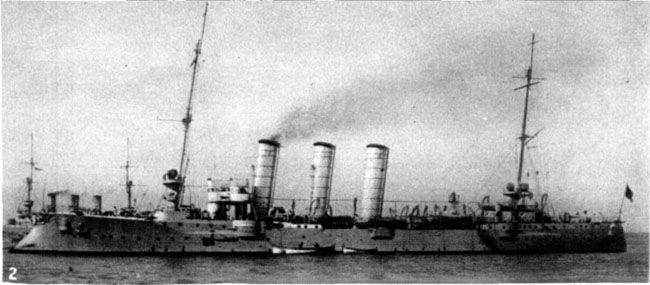
A Bremen class cruiser underway, note her two-tone livery, dark grey hull and light grey superstructures
The Bremen-class hull was longer than the previous Gazelle, with 110.6 meters (362 ft 10 in) long at the waterline, 111.1 m (364 ft 6 in) overall, versus 105 m. They also had a superior beam at 13.3 m (43 ft 8 in) versus 12.20m for the previous cruisers, and a draft of 5.28 to 5.68 m when fully loaded (17 ft 4 in or 18 ft 8 in) versus 4.11 up to 5.38 for the former.
These larger dimensions traduced into a displacement of 3,278 metric tons (3,226 long tons) as designed, an increase of 700 tons or about 1/6, which was quite an increment. The Bremen class displaced also and between 3,652 to 3,816 t fully loaded (versus 3,500 on the last Gazelle class). They had flush decks and a pronounced ram bow while the previous Gazelle had a stepped hull with forecastles. For construction, they used the same basic scheme of transverse and longitudinal steel frames.
These ships were generally reputed good sea boats, rolling up to 20° but at least with a gentle motion and predictable speed. They appeared very wet at high speeds, “plowing” heavily and having slight weather helm. Their rudder allowed them still to turn tightly and stay agile. In a hard turn, their speed fell up to 35 percent. Transverse metacentric height was 0.58, up to 0.61 m (23 to 24 inches). In standard they carried a complement of fourteen officers and from 274 to 287 ratings, later increased to 19 and 330 in WWI. Their small service boats fleet included a steam picket boat, a pinnace, two cutters, two yawls, and one dinghy.
Armour protection
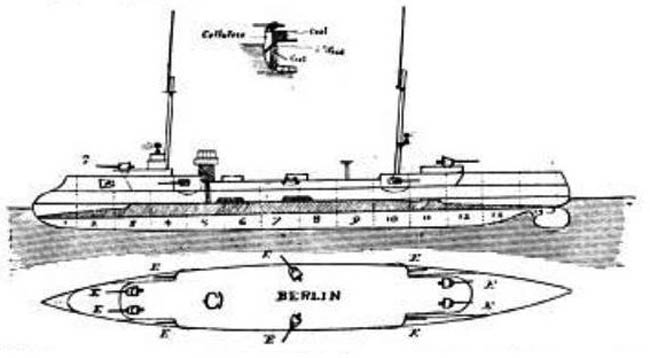
Bremen-class plan and profile drawing Brasseys
The major difference for protection compared to the previous Gazelle, was their deck armour, which went up to 80 mm (3.1 in), sloped down to join the unarmoured belt, with 100 mm faces (4 in) against plunging fire and sloped armor 50 mm (2 in). For ASW protection, the Bremen class incorporated twelve watertight compartments. Most were filled, used as coal bunkers. In addition there was a double bottom running for 56% of the total length of the hull.
This was significatly better than the Gazelle, which only protection was limited to an armoured deck ranging from 20 mm (0.79 in) to 25 mm (0.98 in) for the waterline slopes. At last, there was a conning tower, with walls 100 mm (3.9 in) thick, topped by a 20 mm (0.79 in) roof. The main guns received at some point shields 50 mm thick.
Propulsion
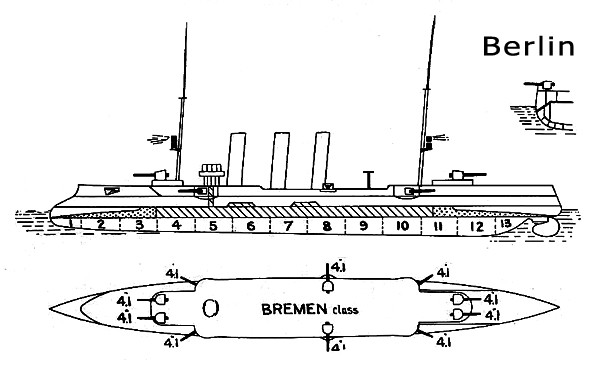
SMS Berlin diagram – Brasseys
The six cruisers propulsion system had two triple-expansion steam engines. A classic formula inherited from previous Gazelle class, each driving two screw propellers. SMS Lübeck, the fourth cruiser on seven differed completely in having two Parsons steam turbines, manufactured in UK, by Brown, Boveri & Company. They were mated on four screw propellers shafts. At the time, German manufacturing was still trying to produce reliable steam turbines.
However all seven ships had the very same boilers, ten coal-fired Marine-type water-tube models. This was two more than on the Gazelle, and they were truncated for this reasons into three funnels instead of two, the major giveaway for identification. These three funnels amidships were raked and heavenly spaced. SMS Bremen and Hamburg, the first two, differed from the pack in having three generators producing a total output of 111 kilowatts/110 volts. The rest were given two new smaller generators rated at 90 kilowatts for 110 volts.
The Bremen class triple-expansion engines were rated for 10,000 metric horsepower (9,900 ihp), to compare to just 6000 ihp (4500 Kw) on SMS Gazelle, and 8000 ihp (6000 Kw) for the other Gazelle class. This however did not traduced, contrary to what was expected, from previous cruisers: The Bremen class were expected to reach a top speed of 22 knots (41 km/h; 25 mph), Lübeck with her turbines (producing 11,343 metric horsepower or 11,188 shaft horsepower) reached 22.5 knots (41.7 km/h; 25.9 mph). The previous Gazelle class reached all 21.5 kts. Nevertheless the Bremen class ships exceeded these speeds on trials, beyond 22 knots.
For endurance, the Bremen class carried 860 tonnes of coal; This gave them an overall range of 4,270 nautical miles (7,910 km; 4,910 mi) at 12 knots. This was not better than the Gazelle class, reaching from 3,560 to 4,400 nmi (6,590 to 8,150 km) at the same speed. SMS Lübeck however had turbines, notoriously less efficient and her max radius of action was 3,800 nmi (7,000 km; 4,400 mi). With some improvements in internal accomodations allopwing to carry more coal, the last three, München, Leipzig and Dantzig reached however 4,690 nmi (8,690 km; 5,400 mi).
SMS Lübeck nevertheless was a breakthrough as being the first cruiser to test a steam turbine in the whole German navy and fastest of all warships in Germany on trials; Due to vibration issues and standardization, her four shafts were replaced by two during a modernization.
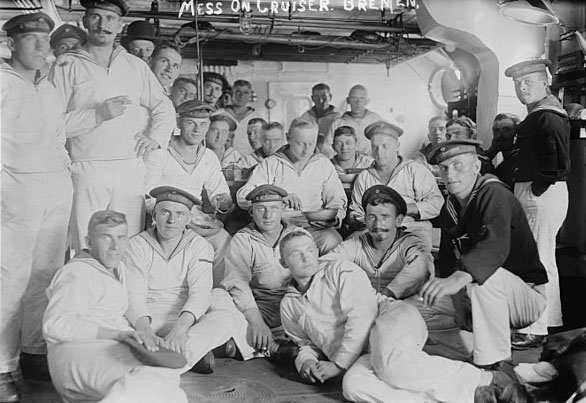
Mess on Bremen (Lib. of Congress)
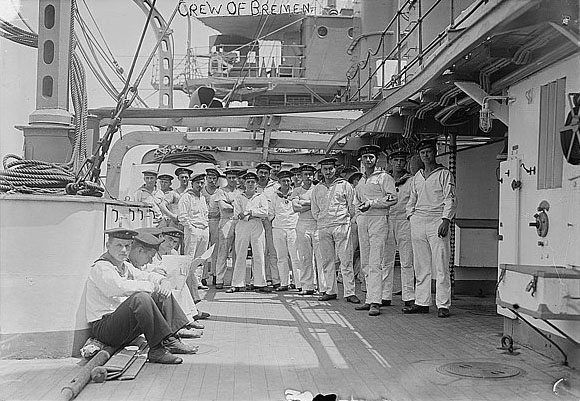
The crew posing in Hampton Roads (Lib. of Congress)
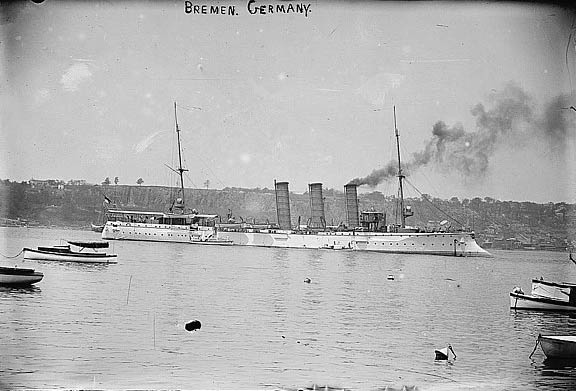
Bremen in Hampton roads (Lib. of Congress)
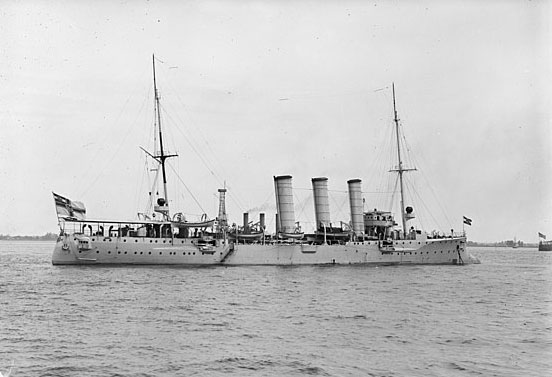
same
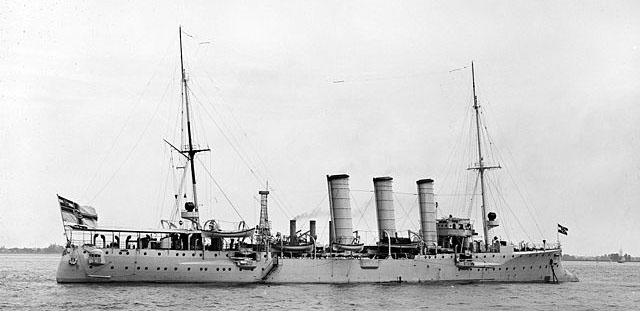
same
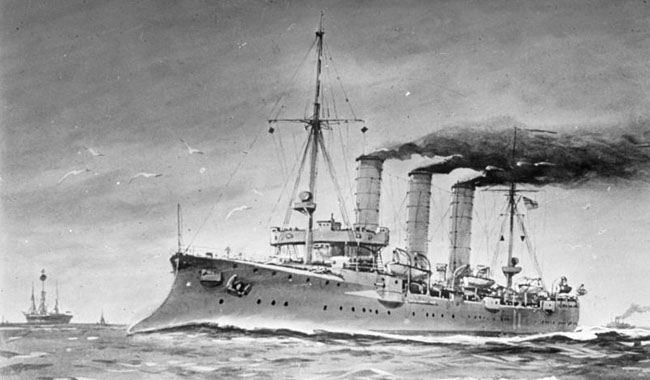
An engraving of SMS Berlin
Armament of the Bremen class
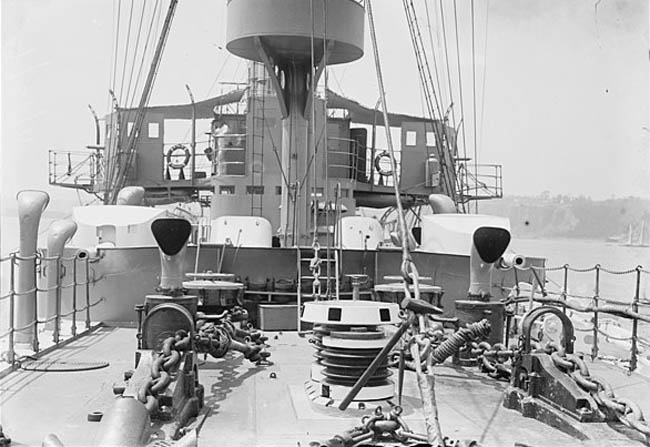
Amidship main deck gun being operated (Library of Congress coll.)
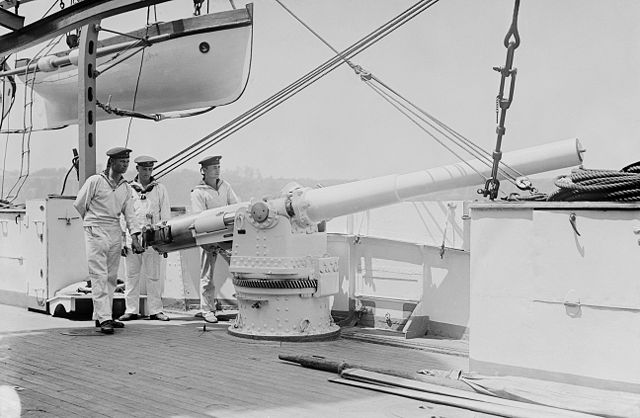
Forward view of the shielded deck guns, SMS Bremen off Hampton Roads. Notice the large wave breaker acting as secondary protection. The conning tower is visible behind and the bridge above.
The small size of the cruisers meant armament was kept to a standard. Like the previous Gazelle class, the same ten 10.5 cm (4.1 in) SK L/40 guns. These trusted ordnance were placed by pairs all along the ships, one of each forward and stern deck, four in barbettes under hull recesses and two alongside the hull and behind, amidship. This was a 1,555 kgs (3,428 lb), 4.475 m (14 ft 8.2 in) long overall gun using a horizontal sliding-block breech design. It fired an AP or HE shell with a fixed Brass Casing, 105 millimetres (4.1 in) x 656 millimetres (25.8 in), the shell weighting 16–17.4 kilograms (35–38 lb) depending on the type, HE or AP respectively. Elevation was -10° to +30° and the Rate of fire 15 RPM. Muzzle velocity was 690 m/s (2,300 ft/s) and max range 12,200 metres (13,300 yd) at max elevation.
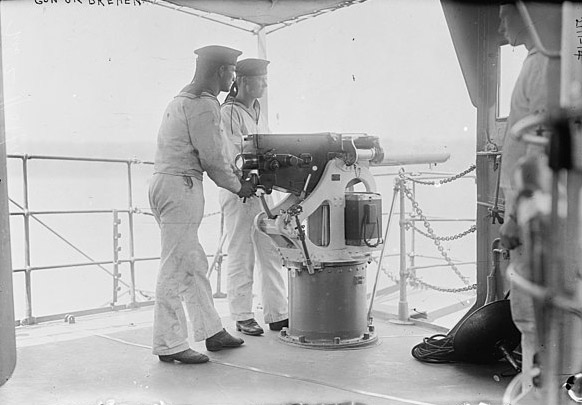
This armament, contrary to the earlier Gazelle class, was completed by ten 3.7 cm (1.5 in) Maxim guns. These were basically among the first “rapid-fire” or QF guns ever designed, meant to pummel approaching torpedo boats. They were basically scaled-up Vickers heavy machine guns (cal. 0.5 inches), already scaled-up version of the famous liquid-cooled 1890s machine guns created by Harold Maxim.
This ordnance was known in the Royal Navy as the QF 1 pdr Mark I (“pom-pom”), well exported. In Germany it was produced for both the Navy and Army and derived as an anti-aircraft gun, the Maxim Flak M14. It had a ~300 rpm (cyclic) rate of fire, a muzzle velocity of 1,800 ft/s (550 m/s) and a maximum firing range of 4,500 yards (4,110 m). On the Bremen class they were located all along the deck in single pintle mounts. In total, the Bremen class carried 150 rounds per guns, 1,500 total.
Late part of this armament, the Bremen class carried two 45 cm (17.7 in) torpedo tubes, with five torpedoes in reserve. They were submerged, on each broadside.
SMS Bremen, old author’s illustration in 1914.
⚙ Bremen class specifications |
|
| Dimensions | 111,1 x 13,3 x 5,61 m |
| Displacement | 3,757t – 4,600t FL |
| Crew | 288 |
| Propulsion | 2 shaft TE engines, ? boilers, 11.750 hp |
| Speed | 23 knots top speed |
| Range | 450 nmi@ 12 knots |
| Armament | 10x 105mm, 10x 37 mm HMGs, 2x 500 mm TT Sub, 80 mines |
General assessment of the class
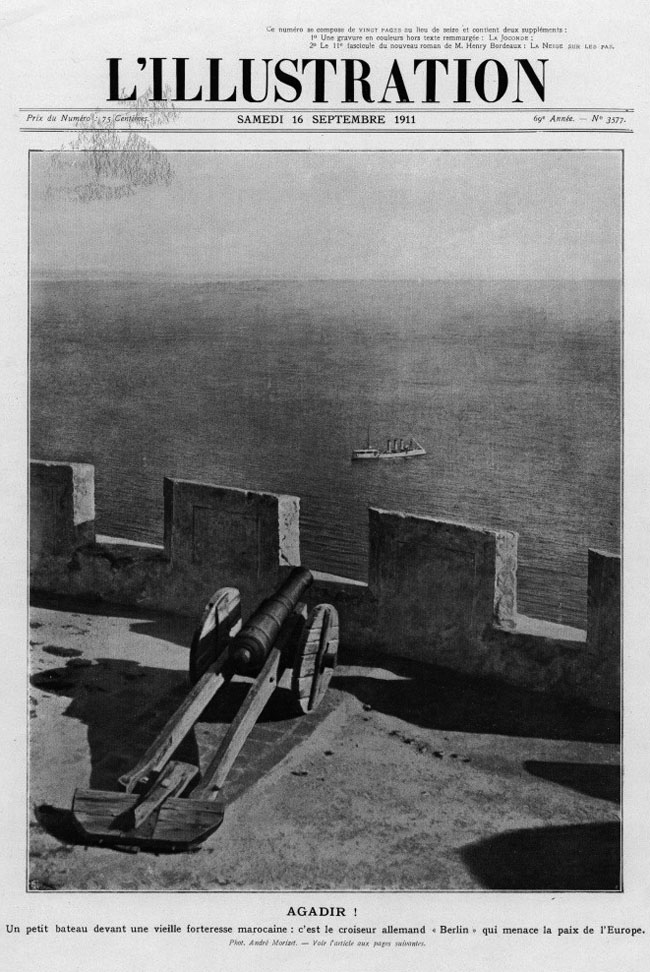
Agadir crisis (L’illustration newspaper), with Berlin in the background.
The Bremen class at large were seen at the time, like today, as quite an improvement over the Gazelle, being larger, roomier, faster, better armed and protected, they proved they could be something else that just glorified station gunboats for far away stations. The only disappointment came from SMS Lübeck, the first German steam turbine-drive cruiser in Germany. At the time, she was equipped by British Parsons turbines replicated in Germany, with many components provided by Krupp. The problem was it was a new tech to master and these equioments did not passed quality control, delaying much her entry into service. Worst still, SMS Lübeck lackluster sea trials (she ended as the slowest of the class, quite the opposite of what was expected) almost doomed the arguments of some young officers in the fleet to push towards this new technology. Also, SMS München pioneered another, vital system, wireless communication, helping to to its adoption in the German Navy. Indeed long range communication was found inadequate in several occasions, including as the July crisis ended with a state of war with ships caught in distant outposts. SMS München also served as target practice for U-1 and helped considerably the development and trust into the future U-Boat arm in the German Navy, far from being accepted back in 1905-1906.
For “colonial duties”, if its was the case for two, which indeed served all their peacetime years in the America and Asia stations, the rest served with various Scouting squadrons, basically screening units for the Hochseeflotte and played an active part in all the sorties of the fleet until Jutland. Some saw action in the latter, but due to adverse conditions, heavy weather or night, accuracy was poor and nothing definitive can be said on their battle performances, but for SMS Leipzig, which served in Asia most of her active years. Part of Von Spee’s famous squadron, she fought at Coronel, engaging HMS Glasgow twice, here and at the Falklands, where the latter chased her. Each time, despite her slower speed and weaker armament, she almost repelled the British cruiser, but was batterred and finished off by the larger armoured cruisers HMS Cornwall and Kent, still succeeding in hitting Cornwall eighteen times, firing her torpedoes. Its only when all her guns were silenced she was abandoned, and not striking the colors had terrible consequences, not lowering in any way the gallantry showed by her crew.
For those which stayed in home waters, post-Jutland years were pretty inactive: The front ate manpower, and the fleet failed to attract recruits enough, so as to be confronted to a sever shortage after the summer of 1916. So much so, that in several cases, the “old” Bremen-class were simply placed in reserve, left with a skeleton crew, much needed on more modern vessels. Only Hamburg and Berlin survived the treaty of Versailles, “granted” to the new interim navy, and then Reichsmarine of the interwar. Due to their age, they received limited upgrades and mostly served as training ships, bringing cadets, future officers of the Kriegsmarine, around the world.
Read More/Src
10.5 cm/40 (4.1″) SK L/40 archives
About the 10.5 cm/40 (4.1″) SK L/40
Gardiner, Robert. Conway’s All the World’s Fighting Ships 1860–1905
Campbell, N. J. M. & Sieche, Erwin (1986). “Germany”. Gardiner, Conway’s
Gröner, Erich (1990). German Warships: 1815–1945. I: Major Surface Vessels.
Halpern, Paul G. (1995). A Naval History of World War I. Annapolis
Herwig, Holger (1980). “Luxury” Fleet: The Imperial German Navy 1888–1918. Amherst: Humanity Books.
Hildebrand, Hans H.; Röhr, Albert & Steinmetz, Hans-Otto (1993). Die Deutschen Kriegsschiffe: Biographien
Massie, Robert K. (2003). Castles of Steel. New York City: Ballantine Books.
Nottelmann, Dirk (2020). “The Development of the Small Cruiser in the Imperial German Navy”. Jordan, John Warship 2020 Osprey
Rohwer, Jürgen (2005). Chronology of the War at Sea, 1939–1945: The Naval History of World War Two. Annapolis
Staff, Gary (2008). Battle for the Baltic Islands. Barnsley: Pen & Sword Maritime.
Staff, Gary (2011). Battle on the Seven Seas. Barnsley: Pen & Sword Maritime.
Dodson, Aidan; Cant, Serena (2020). Spoils of War: The Fate of Enemy Fleets after the Two World Wars. Barnsley
Koop, Gerhard & Schmolke, Klaus-Peter (2004). Kleine Kreuzer 1903–1918: Bremen bis Cöln-Klasse
Tarrant, V. E. (1995). Jutland: The German Perspective. London: Cassell Military Paperbacks.
Model kits
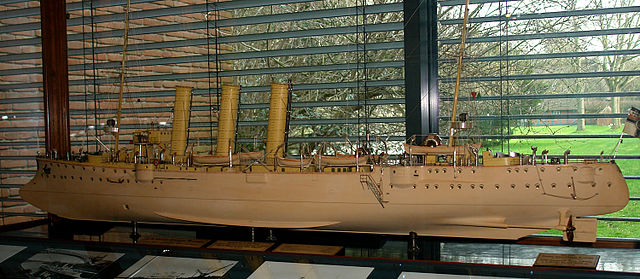 Large metal model of the class
Large metal model of the class
SMS Emden Blue Ridge Models | No. BRM-70046 | 1:700
Book: Kleine Kreuzer 1903 – 1918 Bremen- bis Cöln-Klasse, Gerhard Koop, Klaus-Peter Schmolke
Wartime service
SMS Bremen (1903)
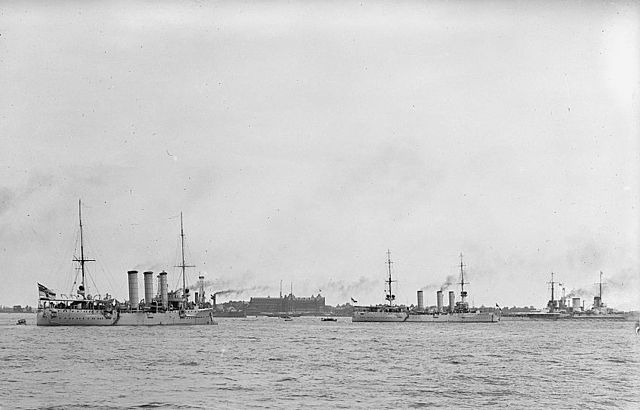
SMS Bremen, Stettin and Moltke in Hampton Roads, 1912 (Lib. Congress)
SMS Bremen was ordered under contract name “L” at the AG Weser shipyard on 1 August 1902. Launched on 9 July 1903, christened by the city mayor, Dr. Pauli. She was towed afterwards to the Kaiserliche Werft for completion in Wilhelmshaven and commissioned for sea trials on 19 May 1904. Her first commanding officer was Korvettenkapitän Paul Schlieper. She reached 23.29 knots at this occasion, way better than specified, to the delight of the both the admiralty and yard, as she was the lead ship of her class. This made her one of the fastest cruiser at the time worldwide, and it was achieved using VTE engines. Trials ended successfully on 15 July and due to the policy of the time she was to be decommissioned. Instead she was sent to replace SMS Gazelle, the lead ship of the previous class, on the American Station. KK Richard Koch became her new captain from then on.
American Station service
After preparations for her deployment in Kiel, she left on 27 August, crossing the Atlantic while coaling en route to Funchal, Madeira, before reaching Rio de Janeiro on 25 September. She was soon placed under the authority of the American station’s flagship Cruiser Division SMS Vineta. The Venezuelan crisis in 1902–1903 opposed the latter to Britain, Germany, and Italy over economic issues, but was settled, so Bremen was detached instead on a cruise, showing the flag and protect German economic interests overseas, and bringing diplomatic muscle. The German division at the Danish port of Charlotte Amalie (Saint Thomas in the Carribean or Danish West Indies) became her main base.
She cruised with the gunboat SMS Panther until mid-April 1905, both anchored in Kingston, Jamaica, until the division was dissolved. SMS Bremen became the new local station ship and spent the rest of the year in training exercises with Panther. She later visited Newport News in Virginia until 23 May, making a short overhaul. She cruised in Central American waters, stopping at Veracruz, hosting members of the Mexican government.
In 1906, she made another short overhaul at Newport News until 14 May, then toured the east coast of South America, stopping at Bahía Blanca (Argentina), and on return, Port of Spain in Trinidad, then Kingston, where she received a distress call from the Hamburg America Line (HAPAG) as the SS Prinzessin Victoria Louise ran aground on a coral reef. She took off the passengers but failed to pull her free and the steamer was abandoned. In December 1906 Fregattenkapitän Hermann Alberts took command as she made another short overhaul in Newport News until April 1907.
Next, she joined the armored cruiser Roon to be present at the Jamestown Exposition commemorating (300th anniversary of the arrival of colonists in Chesapeake Bay), which took place on 26 April. Bremen toured harbors along the East Coast until back to her American station. In June 1907 she cruised north, into the Saint Lawrence River and stopped in Montreal, Canada, then along the Labrador. The crew’s conduit during the visits had Kaiser Wilhelm II sending a congratulation telegram.
SMS Bremen arrived in Port-au-Prince (Haiti) on 16 March 1908 to evacuate and protect threatened German nationals, whereas soon the Haitian government suppressed the revolt. She left with 57 Germans, heading to Kingston. She visited Philadelphia until 9 June, first ever German warship there, then New York, and back to South American waters. She assisted the Hamburg Süd (HSDG) steamer SS Cap Frio after running aground in Bahía Blanca, taking off passengers and crew. Next she was in Punta Arenas in Chile on 10 November, crossed the Strait of Magellan for the east coast. In November FK Albert Hopman was her new commander. After La Guaira, (Venezuela) by early 1909, her captain made a state visit to President Juan Vicente Gómez.
She was back in the Atlantic, making it Havana, Cuba, until mid-1909, helping supressing an harbor fire, then made a refit at Newport News until 15 May. After Haiti, Veracruz, she escorted SMS Victoria Louise, Hertha with the new Dresden at the Hudson–Fulton Celebration in New York.
300 German sailors took part in the international parade while FK Ernst Goette took command. They separated and depared on 14 October, Bremen sailing to Buenos Aires in December, meeting there the French armored cruisers Gueydon and Dupetit-Thouars.
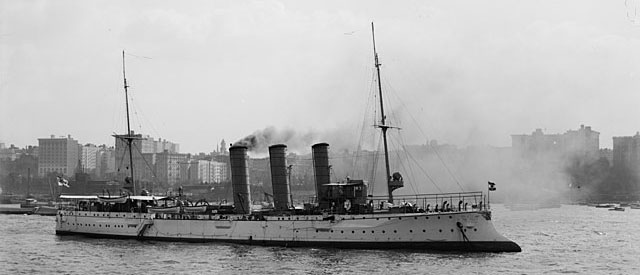
SMS Bremen in NyC, 1909
By January 1910, Bremen was in Punta Arenas, and sailed to Tocopilla on 16 March, instructed to return to Argentina for the independence centennial, weathering a hurricane during the night of 29 April underway. There, she suffered an accidental explosion in her starboard side auxiliary engine room, but there was no fatality. She was in Buenos Aires on 10 May with Emden, staying until 15 June for repairs and a new cruiser along the coast of South America, ending in Callao (Peru), before being ordered back to Chile and be present at its own centennial Independence, held in Valparaiso until 3 October.
After a stop at Guayaquil (Ecuador), she wasn sent in Amapala (Honduras) to embark threatened foreigners, alongside British and US ships, also protecting civilians. They joined forces and sent an international landing party to defend their respective consulates, and the international quarter. Bremen departed on 13 November for Puerto San José (Guatemala), then Puntarenas (Costa Rica) conducting a survey of the harbor until 14 December, while the crew was on leave, some to visist German nationals. Captain Goette took part in the funeral of President Pedro Montt on 3 February 1911 and the cruiser was back in the Alantic on 28 February.
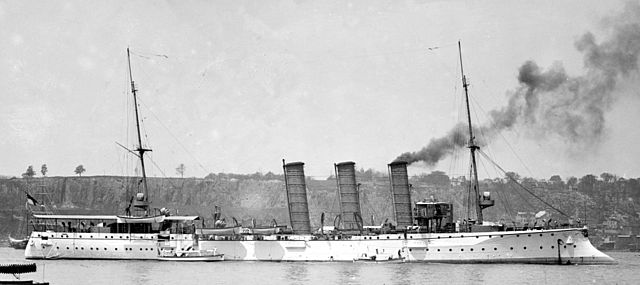
SMS Bremen off Hampton Roads, 1912
After a stop in Rio de Janeiro (19 March) she met SMS Von der Tann, for her shakedown cruise, before making an overhaul in Newport News, until 22 May. From Canadian waters in July, she was recalled to Haiti as a revolution just has broken out, sending landing parties in Port-au-Prince in August, leaving with nationals on board on 15 August. She made another overhaul in Newport News until 24 November, while Captain Hans Seebohm took command. In early 1912 she toured the Gulf of Mexico, and returned to the United States, later in April joining Moltke and Stettin off Cape Henry in Virginia, making the Detached Cruiser Division for an official visit, answering an USN visit in Kiel the previous summer. On 3 June they were in Hampton Roads for ceremonies and departed by mid-June.
SMS Bremen went through the Strait of Magellan, then back to Pernambuco in Brazil (20 December 1912), ordered this time to West Africa, supporting the gunboats Eber and Panther off Liberia. She left on 12 January 1913 via Freetown (Sierra Leone) and ordered to proceed back to Germany in late June (which was cancelled later). Back in Rio de Janeiro, she help putting down a fire onboard HSDG SS Etruska. She sailed newt to Saint Helena, Duala (German Cameroon), Freetown, Las Palmas (Canary) and by late September Funchal. She waitd for her replacement, SMS Karlsruhe, made ready to be replaced by Dresden.
This left her time to assist to the Mexican Revolution, protecting her nationals, with US Navy warships, on all cities along the east coast of Mexico. This ended in January 1914. She protected not only German, but also Austro-Hungarian, Dutch, French, and Spanish civilians, escorting SS Kronprinzessin Cecilie and SS Bolivia during the evacuation.
On 21 January, she was replaced as planned by SMS Dresden, but before returning home she steamed to Port-au-Prince for another protection missions of Germans there, relieving SMS Vineta. When the instability ceased the departed for Germany, after 9.5 years in the American station. She arrived in Bremen for a celebration held on 15 March 1914, then was moved to Wilhelmshaven to be decommissioned.
SMS Bremen in World War I
Contrary to her long American career, her wartime participation was short and brutal. She was sent in Kaiserliche Werft (Wilhelmshaven) for a full modernization, including four 10.5 cm for and aft replaced with two new 15 cm (5.9 in) SK L/45 guns in the axis. Her electrical system was modernized and improved, a new forward mast installed with a better spotting top. By July 1914 she was still in drydock, and this went on until 27 May 1915. Recommissioned, she completed her sea trials, being assigned to the Baltic Sea fleet.
From Kiel, she was in Libau in July, as part of the Reconnaissance Baltic Sea Command Sqn. (Konteradmiral Hopman). She was prepared for eastern Baltic operations, joining a sweep with the IV Battle Squadron north of Gotland. On 14 July, submarines both ambushed but missed her. Soon after, Kommodore Johannes von Karpf, visited Bremen on 30 July, and by early August 1915, she joined the push into the Gulf of Riga.
She was present at the Battle of the Gulf of Riga (8 August 1915), sailing from Libau to rescue the crew of the T52 after hitting a naval mine off Zerel, Ösel. She picked up survivors, transferred to SMS Braunschweig, then join the squadron entering the Gulf of Riga and on this 8 August, engaged in battle for the first time in her carreer, duelling with the Russian armored gunboat Khrabryi. On 16 August she was part in another push with Graudenz, Augsburg and Pillau, with Nassau and Posen in backup. They were shelled on arrival by the Russian pre-dreadnought Slava, but the latter withdrawn and by chasing her, penetrating minefields on 19 August in the Gulf. Bremen shelled Arensbur but had to withdraw due to the presence of British subs.
SMS Bremen was eventually ordered back to the North Sea, taking part in a sweep north of Gotland (September). On 30 September, Kommodore Hugo Langemak took command, as Bremen headed for the coast of Gotland (5-6 October) and conducted other sweeps into the northern Baltic. While on patrol with V191 and V186 (17 December) she met her fate, by entering a uncharted Russian minefield. V191 hit and sunk at 17:10, and while Bremen moved to rescue her, she struck two mines as well and sank quickly, her hull broken, carrying 250 men and leaving only 53 survivors, onboard a crowded V186, already with V191 survivors.
Hamburg (1903)
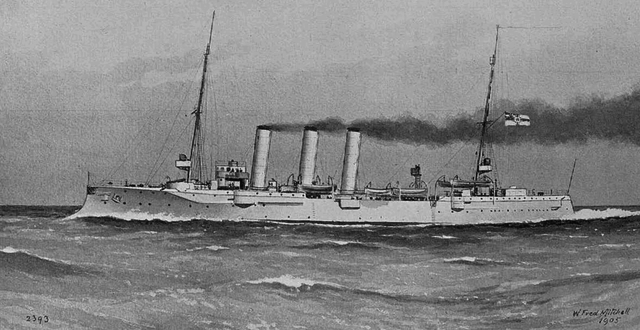
SMS Hamburg on Brassey’s naval annual 1905
SMS Hamburg was as “K” to AG Vulcan shipyard, Stettin, laid down in August 1902, launched 25 July 1903 and Christened by the First Mayor of Hamburg, Johann Heinrich Burchard. Then she was moved Kiel for fitting-out, and although not the first launched, she was the first of her class to enter service, commissioned on 8 March 1904. As defined in the naval law she was assignated from the start as the escort for the Imperial Yacht Hohenzollern. Delays in sea trials had her joining the Kaiser in June. She stayed with the Yacht for three months, from Kiel to Hamburg, where Wilhelm II embarked for a regatta in Norway from 7 July to 9 August and seeing the fleet maneuvers of late August-September.
Interwar service
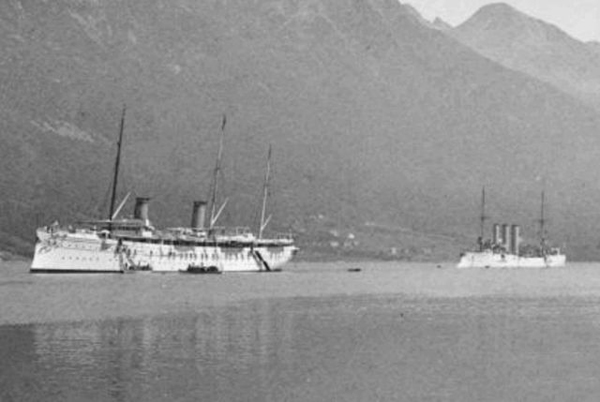
HMS Hamburg and the Imperial Yacht Hohenzollern in Aandalsnaes, Norway, 1904.
From 28 September, Hamburg joined the Reconnaissance squadron, replacing the oldier SMS Niobe. This was followed by a winter training cruise in the Baltic Sea. A yearly cycle of peacetime routine commenced with summer fleet exercises and winter cruise, but in 1905 she was sent for another escort mission of the Hohenzollern, to Helgoland, Pillau and Glücksburg. She also cruised with with SMS Lübeck to compare their performances. In September 1906, Fregattenkapitän Oskar von Platen-Hallermund took command for a year, before being replaced by Korvettenkapitän Ernst Ritter von Mann und Edler von Tiechler.
In February 1908, SMS Hamburg started her training cruise into the Atlantic with the whole Reconnaissance squadron, going south in Vigo, Spain, but she was soon detached to escort Hohenzollern in March-May for a mediterranean cruise. They stopped in Venice, Corfu and back in mid-May to Germany. She later trained in the North Sea and with the High Seas Fleet in a large coordinated exercize. In 1908–1909, she was to be replaced by SMS Dresden, but the latter experienced turbines problems. By February 1909 she retunrned in Spain, Vigo, followed by another escort mission of the Kaiser’s yacht in another Mediterranean cruise with SMS Sleipner, to Venice and Corfu.
While in Corfu on 16 April, the Kaiser was reported Christian persecutions in the Ottoman Empire, which prompted reaction throughout Europe and ships were sent to the southern Anatolian peninsula, Hamburg detached as well on 21 April, first to Mersina, joined by HMS Swiftsure and Victor Hugo, Lübeck, before sending landing parties ashore together to protect civilians, distribute food and care. On 17 May, Hamburg was detached back home, stopping in Port Said and Málaga on her way back to Kiel.
Back to Germany, Hamburg was soon sent to escort Hohenzollern in company of SMS Gneisenau. They departed Kiel on 13 June for Neufahrwasser as Wilhelm II embarked aboard Hohenzollern, for a cruise in the northern Baltic to Finnish waters, for an official meeting of Tsar Nicholas II aboard his own yacht. She was back to Kiel on 20 June but returned with Hohenzollern for a sailing regatta in June-July, and celebrate a new German-Swedish passenger ferry line with Trelleborg, then another cruise on 18 July-3 August. She took place in annual fleet maneuvers for the first time in her career before being decommissioned in Wilhelmshaven, on 15 September, replaced in the scout squadron by Dresden.
SMS Hamburg spent 1910 and 1911 in reserve, while overhauled. Recommissioned on 2 July 1912 she became the second command flagship for I U-boat Flotilla (Torpedo-craft Inspectorate) from 6 August, and took part in training exercises in the North Sea, fleet maneuvers, and the routine went on until 1913, with KK Hermann Bauer appinted her new captain from November 1913, until March 1914, before the cruiser was versed to the U-boat Inspectorate.
SMS Hamburg in the great war
From July 1914, the Ist U-boat Flotilla was stationed at Helgoland, with Hamburg as command ship. On 6 August she teamed with SMS Stettin to escorted a U-boats into the North Sea, a sweep tp draw out the British fleet, as the cruisers acted as a bait for the U-boats arrayed behind in ambush. They failed and retuned home on 11 August, ad another on the 7th, until I and II U-boat Flotilla were dissolved and fusioned into a unew unit under the Führer der Unterseeboote, Hamburg as flagship.
She also sailed with IV Scouting Group during the raids on Scarborough, Hartlepool and Whitby on 15–16 December and at at 06:59 on the 16th Hamburg, Roon, and Stuttgart stumbled upon British destroyers (Loftus William Jones) which did not engaged but shadowed them until 07:40, when Hamburg and Stuttgart were detached at attack them. Admiral Friedrich von Ingenohl based n this decided to withdraw.
In 1915 she alternated between soties with the IV SG and her static U-boat flagship duties. On 21 April she collided with S21, sinking her while Hamburg experienced serious hull and bow damage, repairs before she sailed for another sortie on 17–18 May and 29–30 May, and a final one on 11–12 September, hosting II. Führer der Torpedoboote Kommodore Karl von Restorff and eventually on 23–24 October. None made contact with the enemy. In 1916 her unit sorties on 5–7, 25–26 March 21–22 and 24–25 April, and the raid on Yarmouth and Lowestoft.
SMS Hamburg was attached to the IV Scouting Group during the Battle of Jutland under command of Commodore Ludwig von Reuter. She departed on 31 May, and screened for the fleet with V73, assigned to the port side of the battle fleet, II Battle Squadron. They only made contact around 21:30, with the 3rd Light Cruiser Squadron but between long range and poor visibility, München and Stettin were the only one to engage them. Hamburg fired only one symbolic salvo in the haze. During the night engagements between cruisers and destroyers her unit reached Horns Reef by 04:00, on 1 June, but in hot pursuit with British cruisers and destroyers. Hamburg was hit several times as a result. While in the safety of Wilhelmshaven, battle damage was assessed. She had 14 killed and 25 wounded and repaired until 26 July.
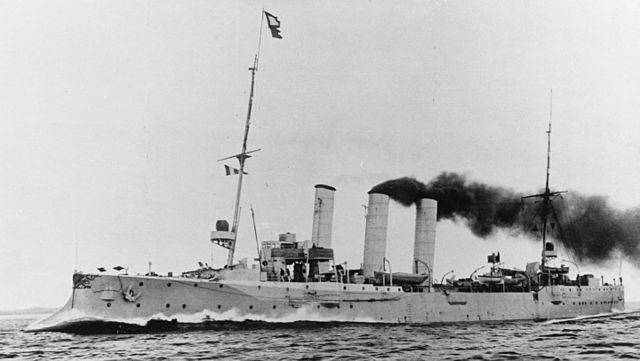
SMS Hamburg Underway, 1915
The post-battle reports showed pre-dreadnoughts and older light cruisers like Hamburg were no longer for frontline operations. SMS Hamburg also never received modernization and both her fire control and limited wireless equipment were not fit to coordinate U-boats at sea. After he last sortie on 18–20 August she served as a headquarters ship in port, then barracks ship for U-boat crews, in Wilhelmshaven, with herself a sekeleton crew due to manpower shortage. From 15 March 1917 she was under command of Captain Friedrich Lützow and spent 1917 and 1918 in the same place, in total inaction. Hamburg was not interned in Scapa Flow, due to her age, and just remained in Wilhelmshaven during peace negotiations. The Führer der Torpedoboote and staff inspected her on February 1919 and it was decided later after the conclusion of the Versailles treaty she would be assigned to the Reichsmarinewerft in Wilhelmshaven, decommissioned on 16 August 1919.
SMS Hamburg interwar service (1920-1936)
Hamburg was left basically to rot during the very troubles years of 1919-21 in Germany. It appeared later she was authorized as part of the 12 cruisers allowed under the Versailles Treaty. She was recommissioned on 7 September (FK Bernhard Bobsien), assigned to Marinestation der Nordsee, flagship, Konteradmiral Friedrich Richter and then Kapitän zur See Walter Hildebrand in charge of the II, IV, and VI Flotillas tasked with clearing the minefields of the North Sea. KAdm Konrad Mommsen took command on 2 April 1921 and the cruiser went for her first interwar cruise, in the Shetland Islands (13-17 June).
In July 1921, SMS Hamburg took part in the first postwar fleet training exercises, with Hannover and Medusa, I and II Flotillas. She escorted minesweepers later as they cleared a minfield from Meteor. In Kola Bay however, they came under fire from a Soviet coastal battery and the Germans returned fire before withdrawing. This was one of the many hostile encounter and “quasi-war” with the Soviets in the Baltic at that time. After their mine-clearing operation, Hamburg toured Norwegian ports (Vardø, Hammerfest, Tromsø, Ålesund, Bergen) and back in Wilhelmshaven in August. In February 1922 she was used an auxiliary icebreaker to assist merchant vessels, but her hull was damaged and she was drydocked later for repairs. Braunschweig replacing her as the flagship Marinestation on 1 March 1922. She visited Odda in Norway and took part in the annual fleet maneuvers after which FK Erich Heyden became her new captain.
In July 1923, Hamburg visited Hanko in Finland, Rønne (Bornholm in Danish waters) but with unrest in Hamburg she was deployed there with two torpedo boats. She sent a landing party ashore to bolster the police efforts to restore order. From 15 October she was reassigned to one of the two Marinestation created while the fleet was reorganized. Hamburg became flagship (KzS Adolf Pfeiffer) light naval forces command, for the North Sea. 1924 was spent in peacetime routine between exercises and a cruise to Riga in July. Later, Hamburg had a new (famous future) captain: KAdm Erich Raeder -albeit briefly- then Kommodore Franz Wieting in January 1925.
She was based by then in Marinestation der Ostsee, Kiel. By May 1925 KzS Ernst Junkermann took command, followed by KzS Paul Wülfing von Ditten and KK Hermann Densch within months. She was transferred to the Training Inspectorate as training ship (FK Otto Groos) and prepared with special accomodation for a major training cruise circumnavigating the Earth, hosting the Mayor of her nameaske city, Carl Wilhelm Petersen which presented the city’s flag in 14 February 1926 ceremonies. From Cuxhaven, and downstream on the Elbe the cruiser reached the English Channel, the Atlantic, stopping at Pontevedra (Spain), Funchal (Portugal), and Las Palmas in the Canary Islands. From the central Atlantic, she crossed to the West Indies and passed through the Panama Canal and visited the west coast of North and Central America, cruising as far north as San Francisco, then the Pacific (Honolulu and Japan, the Philippines, and Manila, Iloilo City), then the Dutch East Indies, the Indian Ocean’s Colombo and British Ceylon, the Red Sea and crossing the Suez Canal, stopping in Vigo en route to Wilhelmshaven, her historic trip ending on 20 February 1927.
This was pretty much a way to end graciously as she was decommissioned on 30 June 1927, reduced to reserve, then stricken on 31 March 1931. In 1936 she was converted by the Kriegsmarine as a barracks ship for submarine crews (her old job) based in Kiel, remaining there until… 1944, when it was decided she was more useful as scrap metal and towed to Hamburg on 7 July 1944 but sunk by British bombers on 27 July and her remained scrapped after the war. Like Berlin, Hamburg bore a famous Germany city name and stayed in service for quite long. Rendition of the cruiser in 1926
Berlin (1903)
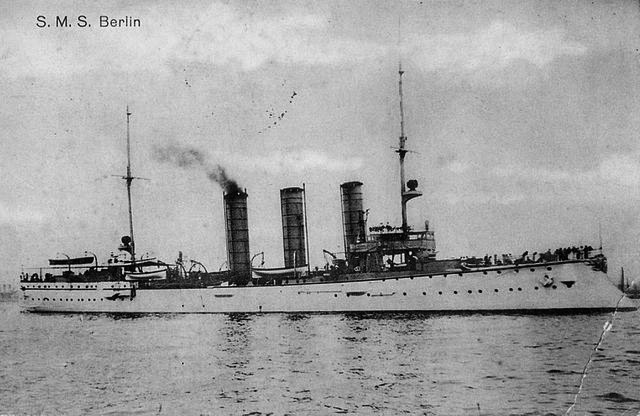
SMS Berlin in colonial livery (postcard) – white hull, canvas sand superstructure.
Prewar career
SMS Berlin was ordered as “Ersatz Zieten”, laid down at the Kaiserliche Werft, Danzig in 1902, launched 22 September 1903 (Chistened by the Mayor of Berlin, Martin Kirschner), completed in Kiel and commissioned for sea trials on 4 April 1905, lasting until 15 June, along with basic training. She was assigned as escort to the Imperial Yacht Hohenzollern for a cruiser starting on 18 June, from the Elbe river, Kiel Week, and Travemünde Week, followed by the annual summer cruise, visiting Gefle in Norway 12-16 July, and an official meeting with King Oscar II representing the Sweden–Norway alliance. Next, a Baltic Se cruise to Björkö, off the coast of Finland to meet Tsar Nicholas II on 23-24 July, then Copenhagen, to meet on 3 August King Christian IX and back to Kiel.
Assigned to the fleet, Berlin started exercizes and drills but no the annual manoeuvers, while Korvettenkapitän Hugo Kraft took command before she joined the Reconnaissance suqadron on 29 September 1905 replacing SMS Amazone, which crew was transferred to Berlin as she was decommisioned, replacing her initial trials crew. No doubt the latter, already experienced, saw the new criser as quite an upgrade. Berlin took part in intensive squadron training in the Baltic by November and fleet maneuvers in the North Sea. 1906-1907 with the same, with pushed to the Skagerrak, May-June fleet manoeuvers and summer cruises plus the annual large-scale fleet maneuvers in September. By October 1907, Fregattenkapitän Arthur Tapken took command.
The then commander of the High Seas Fleet, Admiral Prince Heinrich of Prussia asked to conduct four major training cruises into the Atlantic between 1908 and 1909 so twice yearly. This went down south to Vigo, Spain in February and July, but also Coruña and Horta in the Azores as well as Vilagarcía. SMS Berlin was also detached and assigned to the Imperial escort again, but this time Wilhelm II was aboard the fleet flagship pre-dreadnought SMS Deutschland, on a cruise to Helgoland and Bremerhaven 8-11 March 1908. Afterwards she was recalled to her unit and the training routine resumed, until in 1910, Admiral Henning von Holtzendorff replaced Heinrich as fleet commander, focusing on training exercises in the North and Baltic Seas instead of the not very useful and costly Atlantic cruises. In case of conflict indeed, the German Navy would likely clash with Britain (which announced the entente) as well as France. Until then, for a conflict with the French Navy only, Atlantic operations made sense to enforce a blockade, but the latter would have been difficult so close to British shores and in the channel. Berlin made a Norwegian waters summr cruise and had a new captain in September, KK Heinrich Löhlein.
1911 started like all previous years, with a cruise to Norway but in May, Berlin was in maintenance, joining the fleet for Baltic maneuvers and North Sea, but on 27 June, her captain received orders to redeploy to the coast of west Africa: This was the Agadir Crisis, and she was to replace the gunboat SMS Panther. She went through the Kaiser Wilhelm Canal and steamed through the Strait of Dover on 30 June–1 July, reaching Agadir in Morocco on the 4th of july. Panther stayed there too and on 20 July, Eber relieve her. Berlin and Eber made alternating trips to Las Palmas (Canary Islands) to recoal.
As a refresher, the Agadir crisis (also Second Moroccan Crisis or Panthersprung) was sparked by the deployment of French troops in the interior of Morocco in April 1911, which trigerred the deployment of a German gunboat there. Germany did not object to France’s expansion but wanted territorial compensation, that France refused, and to have more weight, dispatched SMS Berlin in reinforcement. despite the objections of German nationalists negotiations were larter held between Berlin and Paris, which resolved the crisis on 4 November 1911 as Morocco became a French protectorate and Germany obtained French Congo (now Rep. of congo, Gabon and centrafrica).
This was not a sound political move however for Germany as in Britain David Lloyd George (Chancellor of the Exchequer) made a dramatic “Mansion House” speech on 21 July 1911 denounced the German move and relations between Berlin and London worsened while Britain moved even closer to France. The deployment showed it was exceedingly difficult to communicate with Berlin, through the long-range Nauen Transmitter Station: French stations in the region indeed of course did not relay German signals and that was to be done by German merchant ships fitted with transmitters in the area instead.
By October 1911, SMS Berlin was recalled, and 3 November, FK Wilhelm Tägert took command while with SMS Eber she sailed back for Germany on 28 November, visiting underway Mogador, Casablanca, and Tangiers but crossed the path of a storm in the Bay of Biscay, damaging her, dlowing her down for repairs at sea during five days and a stop in Portsmouth to coal and complete repairs. She arrived in Kiel on 14 December. In 1912, she resumed her usual Reconnaissance Unit drills, fleet maneuvers of the North Sea and Baltic in summer plus annual fleet maneuvers. On 27 September 1912 she was reaffected to Wilhelmshaven to be decommissioned and replaced from 29 October. She stayed there until mid-1914 with a skeleton reserve crew.
Wartime Career
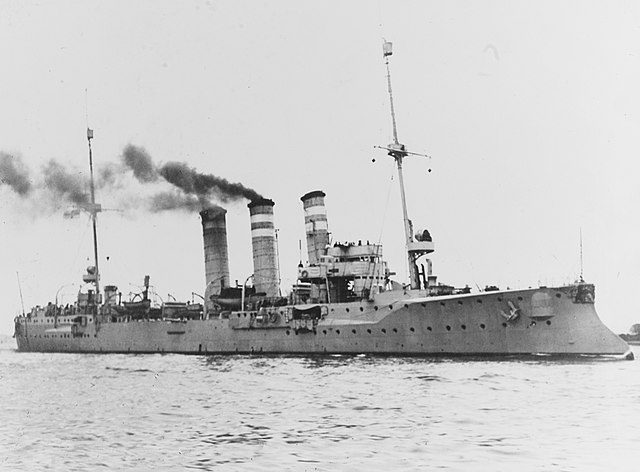
SMS Berlin in 1914, showing her two-tones wartime grey livery and painted funnels for unit identification.
In July 1914, SMS Berlin was reactivated, a crew was mustered and she was recommissioned on 17 August, under command of FK Friedrich von Bülow. After short sea trials in July-August and training on 3-17 September, she was assigned as flotilla leader for the torpedo boat flotilla in Jade Bay, Bülow commanding both. On 17 September however she was reassigned to IV Scouting Group, replaced by the coastal defense ship Siegfried. IV Scouting Group was assembled for western Baltic training exercises in the idea she would be deployed later as a screening force for north sea operations. They were at the time affected to the Coastal Defense Division of the Baltic Sea, patrolling Langeland (Danish straits) in case of a possible attempt of a British raid, which never happened. On 3 October, IV SG was transferred to the German Bight, guarding the German North Sea coast until 24 October 1915.
While IV Scouting Group operated with the High Seas Fleet, Berlin was detached to the II Scouting Group, covering a minelaying operation off Swarte Bank on 17-18 April and off the Dogger Bank on 18 May 1914 when her sister ship SMS Danzig struck a mine, so Berlin took her under tow until a tugboat took over. SMS Berlin had an overhaul on 30 July-28 August, retrofitted with rails to carry 80 mines. She was afterwards detached from IV Scouting Group on 24 October, assigned to the Baltic Sea Naval Forces; First she headed for Kiel and sailed with Stuttgart and V Torpedo-boat Flotilla for Libau. She steamed to Windau area, replacing her sister ship SMS Bremen and towing Danzig struck by a mine to Neufahrwassar (25-26 November 1915).
By early 1916, the Germans started to disengage from the Baltic due to the pace and successes on land, and Berlin was transferred back to IV Scouting Group, leaving on 6 January 1916 with SMS Braunschweig and Mecklenburg escorted by X Torpedo-boat Flotilla to Kiel. She went through the Kaiser Wilhelm Canal and anchored in Wilhelmshaven, afterwhich she had a short overhaul before joining her unit on 3 February, resuming patrol duties in the German Bight. Her fleet sorties were on 3–4 and 25–26 March, as far as Amrun Bank, but for naught. On 18 May she was overhauled in dry-dock during the Battle of Jutland. She was out of the shipyard on 8 June and resumed patrols.
On 19 October while on patrol, SMS Berlin was ambushed by British submarine HMS E38, which launched, but missed, one torpedo however went further to hit SMS München, so SMS Berlon took her in tow back to port, relieved by a tugboat. In December 1916, SMS Berlin was transferred to II Scouting Group but on 14 January 1917 she was reassigned to coastal patrol duty, North Sea and by February sent to Kiel and Danzig for a decommission on 11 February due to her age and the need of her crew for more modern vessels. Disarmed, she was converted into a tender, commander of coastal defense forces (Baltic), a duty held from 26 April 1918 to the November.
Interwar career
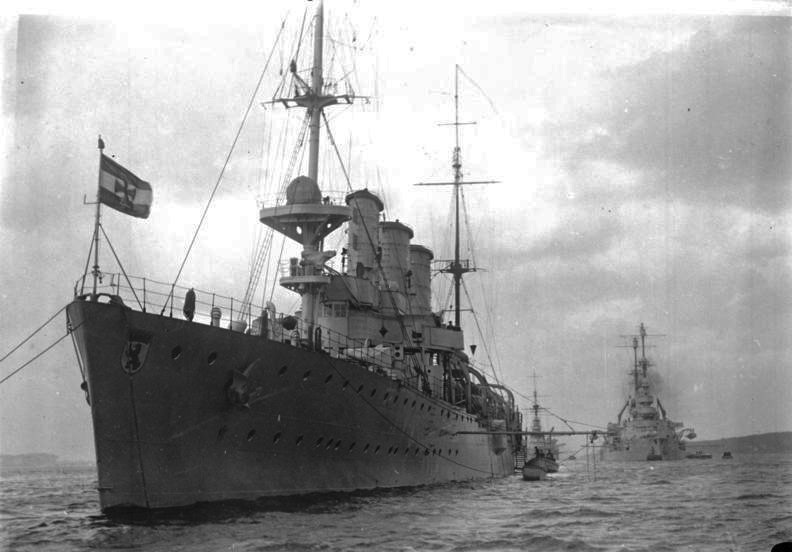
Reichsmarine cruiser Berlin in 1929 after her last great cruise.
SMS Berlin was one of the six light cruisers Germany was allowed to retain by virtue of Versailles treaty. She started as a training hulk for boiler room crews, then was sent to Kiel on 16 December 1919 for this, taking accomodations onboard, and having a new captain, Oberleutnant zur See Clamor von Trotha, until April 1921, then KL Hans Walther. Now into the Reichsmarine, the government decided to reactivate her as a cadet training ship.
She sailed to Wilhelmshaven, decommissioned on 10 June for a drydock overhaul and modernization, the most complete and well-planned of any other German cruiser of that time. She received a new clipper bow, new stern, a modified bridge, lighter aft mast, new radio and communication systems, eight modern 105mm/42 SK C/06 guns and two 500mm TT (New length 110.6m wl and 113.8m oa) – But still apparently the same old coal-burning powerplant. She was recommissioned on 2 July 1922, under command of KzS Wilfried von Loewenfeld (Naval Training Inspectorate). She sailed for her training cruise, with port calls in Scandinavia and the Netherlands. In 1923, she made a longer cruise to Norway, Iceland, and the Faroe Islands while in October 1923, KzS Paul Wülfing von Ditten too, command.
On 15 January 1924, Berlin made her first overseas cruise, the first by any German warship since the end of WW1. She went into the central Atlantic to Ponta Delgada in the Azores and Santa Cruz de Tenerife, Las Palmas (the Canary Islands), Funchal (Madeira) Cartagena (Spain) and back back in Kiel (18 March), followed by annual fleet maneuvers, hosting Otto Gessler, the Reichswehr’s minister. On 1st November she made another Atlantic cruise to as Central and South America, stopping en route to coal at Santa Cruz de Tenerife, Saint Thomas (U.S. Virgin Islands) and visited Cartagena (Colombia), Veracruz (Mexico) Havana, La Guaira (Venezuela), San Juan (Puerto Rico), and Ponta Delgada but she had back luck whent steamiong back through the Bay of Biscay, hit again by a severe storm. While in Kiel from 16 March 1925 she was repaired and KzS Ernst Junkermann took command that year in July.
She made another long range cruise on 9 September, reaching the western coast of South America, Ponta Delgada, Hamilton (Bermuda) Port au Prince (Haiti), Colón (Venezuela), Puerto Madryn (Argentina) Guayaquil (Ecuador), Callao (Peru) and in Chile, Valparaiso, Corral, Talcahuano, and Punta Arenas. While en route back north, she stopped in Mar del Plata, Buenos Aires, Montevideo, and Rio de Janeiro. Back east, she coaled in Vigo and made back to Kiel on 22 March 1926.
From 25 September, it was intended to replace her by the newly commissioned light cruiser KMS Emden, and her crew ws reduced; Under FK Hans Kolbe in command, she was transferred to Marinestation der Ostsee (Baltic Sea Naval Station), conducting a long-range cruise to the central Atlantic (April to June 1927) visiting the Azores, Portuguese and Spanish ports. In Horta (Spain) on 19 May, she assisted a stranded Portuguese sailing ship.
After fleet maneuvers she hosted President Paul von Hindenburg (14 September 1927) coming from KMS Schleswig-Holstein, and carried to Königsberg (East Prussia). KMS Hamburg was decommissioned so Berlin replaced her in the Naval Training Inspectorate, reassigned from 1 October. On 1st December she made her longest cruise ever: Fifteen months in all where she went in East Asia, visiting along the way Fremantle (Australia) and back to Cuxhaven on 7 March 1929, then moved to Kiel to be decommissioned on 27 March. She was in reserve until 1 October 1935 but the Kriegsmarine, under a new leadership had plans to rapidly expand the Navy and needed her for barrack ship purposes (and free her name for more modern vessels), so she was stricken and anchored in Kiel for the subsequent years and World War II. After 1945 she was loaded with nazi chemical weapons, scuttled in the Skaggerak on 31 May 1947. Her remains are still there today.
Lübeck (1904)
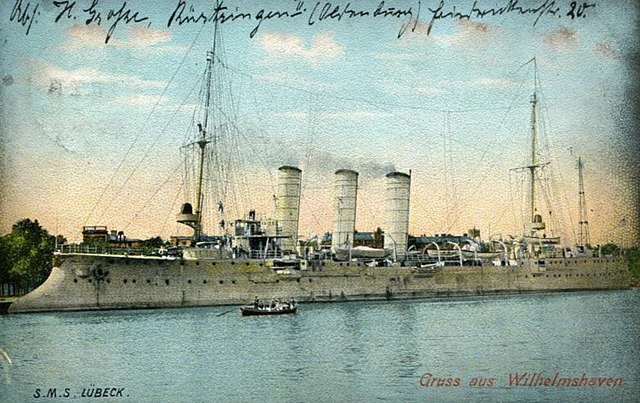
Potscard- SMS Lübeck
SMS Lübeck was ordered as Ersatz Mercur, laid down at AG Vulcan (Stettin) on 12 May 1903, launched on 26 March 1904, christened by the Bürgermeister of her namesake city. Fitting out dragged on, as she waited for the delivery of her turbines. It prevented to close the inner section of the hull, assembled and enclose the armored deck and complete alla above compartments. In all, eight months passed until 1 August 1904, the initial deadline set to Krupp, the components manufacturer of the turbin. The company had indeed significant problems casting the parts, all rejected due to quality issues.
Lübeck’s prewar service
SMS Lübeck finally started builder’s sea trials on 18 March 1905, commissioned for sea trials on 26 April. Fregattenkapitän Alexander Meurer was first in command. Sea trials immediately revealed turbines fell short of expecation and the ship never went close to the intended top speed. In fact, the turbines seemed to give no advantage over triple-expansion. These fed heated discussions over the utility of using turbines in cruisers. The Navy however still experimented with propeller arrangements, going as far as tryin eight screws on four shafts as it was seen on early topedo boats and destroyers. Different propeller sizes, blade pitches and shapes were also tried. In the end, Lübeck became the slowest of the whole class… but with a highest consumption.
On 30 October she was still under testings when the 1905 Russian Revolution prompted the Kaiser to send her, escorted by seven torpedo boats to Russia. He wated to evacuate his cousin, Tsar Nicholas II and his family if the situation degraded. So Lübeck patrolled in the Gulf of Finland before the crisis diffuse, so she returned to her sea trials. Only by March-April 1906 under Korvettenkapitän Hermann Nordmannand then KK Otto Philipp, she started operating as a flotilla leader, for the torpedo boat training flotilla. It went on until 25 April 1906, then with the School and Experimental Ships Unit until 17 May. Then Lübeck started a serie of competitive testing with VTE-equipped SMS Hamburg. On 27 August, her trials were at last concluded. Temporarily placed in reserve in Wilhelmshaven she awaited an assignation.
Reactivated on 22 September 1906 she joined the Reconnaissance Unit of the High Seas Fleet and for two years routinely trained and cruised in between fleet exercises. In October 1906, FK Felix Funke took command. Her 1907 fleet maneuvers were followed by a cruise to Skagen in Denmark and a mock attack on Kiel. After summer esercises in the North Sea, she cruised in Norway and took part in the annual autumn fleet maneuvers, delayed for a large fleet review in the Schillig roadstead for the Kaiser. She also trained with the IX Army Corp off Apenrade and her new captain became FK Ferdinand Thyen. By February 1908, she trained in the Baltic Sea and in summer around Helgoland, before a sweep into the Atlantic and major training cruise by decision of Prince Heinrich.
The latter were made difficult due to tensions with Britain over the Anglo-German naval arms race, starting on 17 July, from the Kaiser Wilhelm Canal to the North Sea, Atlantic and back to Germany on 13 August, followed by the autumn maneuvers until 12 September. In October she had a new captain, FK Robert Kühne and in 1908 toured coastal German cities. She acted as to increase public support for naval expenditures, wildly contested outside Prussia, notably in landlocked landers such as Bavaria and others. Never in its history Gezrmany had ever embarked on such a massive naval expansion, which was never traditional nor natural. The unpopularity of the fleet was notably predicted by naval thinkers such as Alfred Thayer Mahan. Even France, with its large naval exposition, tradition and extensive colonial Empire had a smaller fleet that Germany intended to built.
SMS Lübeck soon redeployed to the Mediterranean Sea on 19 April 1909. She reinforce the gunboat Loreley in Constantinople as serious unrest threatened Europeans residents and assets. Loreley was too small to effectively protect German interests by herself, notably her landing party was way too small. Lübeck patrolled the southern coast of Anatolia in June until recalled home reassigned to the Reconnaissance Unit. She participated in another cruise in the Atlantic this summer, and the Hochseeflotte, as a way to diffuse tensions and spy on the Germans, was invited Spithead, UK.
In May 1910 training maneuvers in the Kattegat were followed by a summer cruise in Norway, and fleet training then naval review off Danzig on 29 August, with Captain Hans Zenker taking command the newt year, in April 1911. This summer, the German fleet hosted a return goodwill visit of considerable magnitude: Both the British Grand Fleet and the American “great white fleet” were hosted at Kiel, for the now famous Kield week, punctuated with festivities and regattas. The autumn maneuvers took place in the Baltic and Kattegat, followed by a fleet review held for the Austro-Hungarian delegation, notably Archduke Franz Ferdinand, Admiral Rudolf Montecuccoli. Eventually, SMS Lübeck was decommissioned on 10 October 1911 with a skeleton crew.
Lübeck in the great war
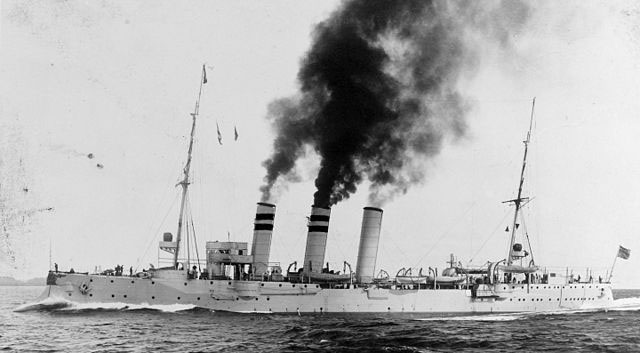
SMS Lübeck underway, date unknown. From Journal of the United States Artillery, Volume 25 (1905)
By July 1914, SMS Lübeck was recommissioned and reactivated fully from 12 August, assigned to the Baltic Sea Coastal Defense Division, patrolling the Skagerrak area, the Little Belt and the Sassnitz-Trelleborg route off Sweden. By October 1914 she was sent to the eastern Baltic, taking part in a series of sweeps into the northern Baltic, the first on 8-13 October (off Bogskär), and on 24-31 October, then a raid on the Russian port of Libau (16–17 November) followed by two other sweeps in December, off Bogskär, Utö, Öland and Gotland.
March-April 1915 saw her engaged in support operations off Memel during the Russian counter-attack, shelling them from the shore. She even became flagship of Kommodore Johannes von Karpf to coordinate the Gorlice–Tarnów Offensive of May at the extreme left flank of the German Army. She spearheaded a diversionary attack on 27 April as stayed for the naval support with SMS Thetis shelling Libau during a landing demonstration, divert Russian attention as expected. Karpf left her for the cruiser Augsburg and in early May, the German still tried to seize Libau, and needed naval support Lübeck and several other cruisers provided on 6 May. She also patrolled the area in search of a possible Russian naval sweep.
Konteradmiral Albert Hopman took the head of the reconnaissance forces in the Baltic and ordered another assault on Libau covered by Lübeck, Augsburg and Thetis, but also Prinz Heinrich, Roon, and Prinz Adalbert, even the old Beowulf flanked by a massive escort of destroyers, torpedo boats, and minesweepers. The IV Scouting Group also joined in to provide additional cover and the bombardment proceeded. The destroyer V107 struck a mine close to the harbor and was lost but the Germans were overall successful and the the city fell. On 14 May, SMS Lübeck was detached to lay a minefield off the Gulf of Finland, with SMS Augsburg but as Russian submarines were spotted in the area, this sortie was cancelled.
During a patrol off Libau, on 28 June 1915, SMS Lübeck spotted and fired on a Russian destroyers squadron. Both sides soon folded up and withdrawn. On 1st July, the minelayer SMS Albatross sortied with Lübeck as an escort as well as Roon and Augsburg, to operate north of Bogskär and while back, Augsburg stayed with Albatross, heading for Rixhöft while the rest went to Libau. However Augsburg and Albatross fell on a powerful Russian squadron (Rear Admiral Mikhail Bakhirev), leading to the Battle of Åland Islands. Karpf ordered Albatross reach neutral Swedish waters, ordering Roon and Lübeck to her rescue. However Albatross was grounded en route off Gotland while Augsburg escaped. The Russian squadron evetually spotted Lübeck and Roon, few shots were exhanged but boths sides broke contact. Lübeck reported scoring eight hits on Rurik, but not hit in return. Hopman sortied with Prinz Heinrich and Prinz Adalbert in between, but too late, while the latter was torpedoed on route by British submarine E9.
Lübeck took also part later in the Battle of the Gulf of Riga from 8 August and on 9-10 August, she was ambushed and torpedoed by the Russian submarine Gepard off the Irben Strait (Gulf of Riga). Five torpedoes came from only 1,200 m (3,900 ft), but Lübeck’s spotters seen them and the captain ordered a hard rudder turn, evading them. Later she was attacked by a Russian aircraft off Windau on 10 September, not damaged. On 6 November 1915 she was also ambushed by British submarine E8, and again, dodged her torpedoes. She was back in Libau in January 1916.
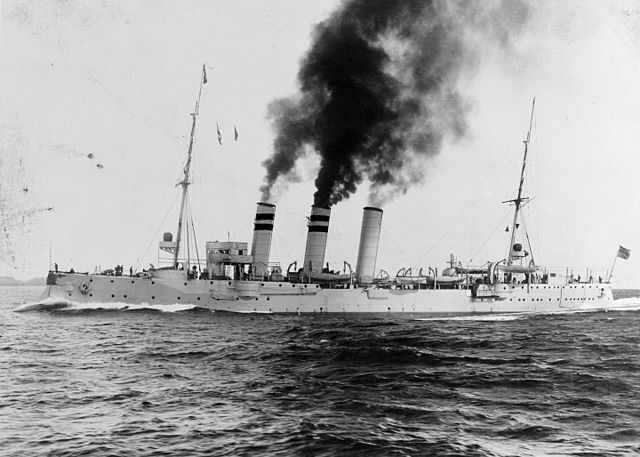
The cruiser’s luck was about to run out. On 13 January, she struck a Russian mine. Her stern was lifted out of the water by the force of the blas, which also knocked down her mast, falling behind on the bridge, torn off and buckled as a result. Two killed, five wounded, 250 t of seawater flooding were the immediate result; She was however under escort and the torpedo boat V189 started towing her to safety, until the tugboat Weichsel took charge. She was carried to Neufahrwasser (close to Danzig) on 15 January, decommissioned on the 28th for provisional repairs, until she could be towed to AG Vulcan, Stettin, her constructor, for complete repairs. At this occasion she was modernized: She was fitted two of the new 15 cm (5.9 in) SK L/45 guns in place of her twin 105 mm foe and aft, and six 10.5 cm SK L/45 guns while the Maxim mounts were removed. This was completed by two 50 cm (19.7 in) torpedo tubes on deck and a new bow was provided, more modern, funnels were replaced by new models. She emerged in early 1917 as the most modern Bremen class cruiser.
however despite of this, crew shortages hit hard and many of her sister ships already has been decommissioned. As soon as she was out of drydock, she was placed in reserve until 15 March 1917, reactivated for use as a target ship, for the U-boat School, with a small service crew. Her new role only started on 11 February 1918. She notably trained the crews of the new massive U-cruisers just completed. Her sister ship ship SMS Stuttgart meanwhile just had been converted into a seaplane carrier, and Lübeck’s crew was chosen to man her. So she was formally decommissioned on 8 March. The Treaty of Versailles had her surrendered to the British as a war prize. She stricken in September 1919, formally ceded as “P”, but the British sold her for BU in 1922, dismantled in Germany in 1923.
München (1904)
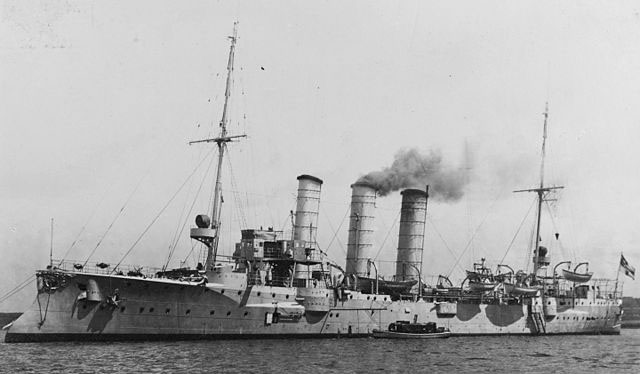
SMS Munchen underway, circa 1910
SMS München was ordered as “M”, laid down in AG Weser in Bremen, on 18 August 1903. Launched on 30 April 1904, she was christened by W.G. von Borscht, mayor of Munich, in a ceremony witnessed by Prince Ludwig III of Bavaria. Fitting-out was quick she she completed and started her initial sea trials by early November. After that she was installed her armament at Kaiserliche Werft, Wilhelmshaven, and underwent Navy acceptance trials, commissioned on 10 January 1905.
München peacetime routine of torpedo & wireless testings
SMS München made a shakedown cruise in the Baltic Sea until 30 March. She was used as a torpedo test ship replacing Nymphe and tested also wireless telegraphy. Following individual training exercises in April and May she had a new captain, Korvettenkapitän Friedrich Schultz before joining fleet training while still affected to the Training and Experimental Ships Unit. This summer, she trained at the western Baltic, off Swinemünde and notably firing tests to digest reports of the recent Russo-Japanese War.
In 1906 she went on on individual and unit exercises and changed captain in March, with KK Ferdinand Thyen. She was in Norwegian waters this summer, stopping at Bergen and Trondheim, sending wireless signals to the recently constructed Norddeich radio station to test long range transmissions. She did the same with Helgoland and Cuxhaven radio stations. KK Johannes von Karpf took command in October and a month later she trained with the old protected cruiser Vineta and the I Training Flotilla, in the eastern Baltic. On 9 December she was drydocked for periodic maintenance, until 25 January 1907.
The 1907, aside her same training pattern, she was visited by Kaiser Wilhelm II in June, seeing U-1 simulated attack against München, a first for the German Navy. After the the annual fleet maneuvers as flotilla leader for torpedo boats and a new captain in winter, KK Ferdinand Bertram she was overhauled in Kaiserliche Werft until 8 February 1908. That year she visited Trondheim, Bergen, and Stavanger in Norway and multiplied wireless experiments. After annual fleet maneuvers as leader of III Scouting Group, Reserve Fleet, Karpf returned to command and she left Kiel on 24 October for a test cruise off Vigo and Málaga, Funchal and Madeira, still testing radio. She was back in Kiel on 17 December. The routine repeated in 1909.
Her overhaul completed in February 1910 she had a new captain in March, KK Ernst-Oldwig von Natzmer and on 13 April during training she accidentally near-rammed the torpedo boat S122, passing in front of her München while trying to reach an attack position. However due the captain’s prompt reaction, her bow took the hull in an oblique angle, so she only had mushed steel and a damaged engine room (but two dead). Taken under tow, the TB was later repaired in Sassnitz.
München’s bow had no significant damaged and she resumed training until November, repaired and overhauled at the Kaiserliche Werft, Danzig. In 1911 she became a torpedo target ship at the Training and Experimental Ships Unit while KK Rudolf Bartels took command. She trained in Norwegian waters in July 1911, participated in a naval review on 5 September. She however lost six men during the the night of 26 October, when lowering a boat to moor the cruiser to a buoy, due to a front rope loosening. She went out of overhaul in January 1912, assigned to the III Scouting Group. This year again she test her wireless in Vigo.
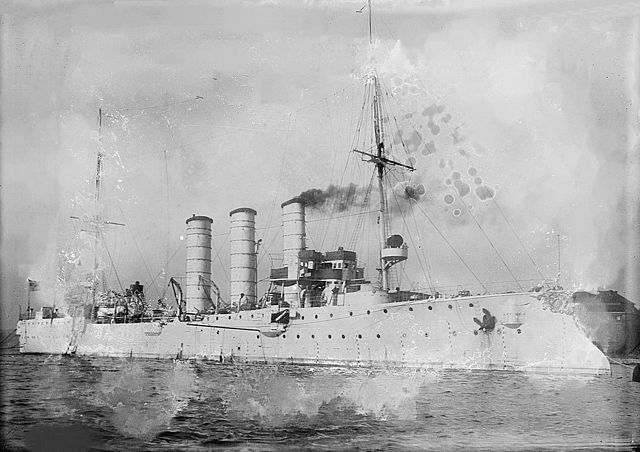
SMS Muenchen Bain picture, congress
This was the same in 1913, but during the annual fleet maneuvers she hosted Wilhelm II, Großadmiral Alfred von Tirpitz (State Secretary of the Imperial Naval Office), Admiral Friedrich von Ingenohl(fleet commander), and Admiral Georg Alexander von Müller (Chief of the Imperial Naval Cabinet). Off the Great Belt on 19 December she again lightly collided with a fast manoeuvering V159, but both only had minor damage. Her last peacetime overhaul was completed on 7 February 1914 and she keep her torpedo training and fleet maneuvers routine until the summer.
SMS München’s WWI operations
SMS München joined the III Scouting Group attached to the High Seas Fleet, planning to do some sweeps in the North Sea. Transferred to IV Scouting Group on 25 August she was foud with SMS Danzig transferred to the Baltic after the loss of SMS Magdeburg, to be soon back to the North Sea. She was moored at Brunsbüttel when the British Harwich Force attacked in the Helgoland Bight, leading to the Battle of Heligoland Bight, where München and Danzig were recalled, steam to the mouth of the Elbe to wait for orders, and ordrered to the Bay at 12:25, in support of SMS Strassburg. At 4:06, however München was detached to make a reconnaissance NW of Helgoland, but she spotted nothing and the battle ended.
Still with IV Scouting Group, Muenchen took part in the 3–4 November 1914 raid on Yarmouth avant-garde by I Scouting Group. She woukd take part also in the 15–16 December raid on Scarborough, Hartlepool and Whitby, as flagship of the II. Führer der Torpedoboote under command of a new captain, Karl von Restorff, but again, seeing no combat. München also took part in the 24 January 1915 raid in support of I Scouting Group seeing action of the 1st and 2nd Battlecruiser Squadrons at the Battle of Dogger Bank, but she arrived too late this afternoon to see action. She was also mobilized for the actions of 29–30 March and 18–22 April.
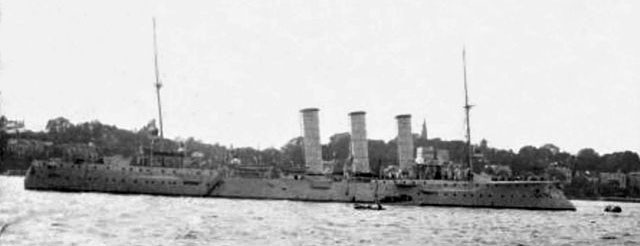
SMS Munchen at the Kieler week
On 7 May 1915 she was in the IV Scouting Group (München, Danzig, Stettin, Stuttgart, 21 torpedo boats) mobilized in the Baltic for a major German push against the strategic port of Libau, under command of Konteradmiral Albert Hopman. IV Scouting Group was to screen the main force to the north, to spot any Russian incursion from the Gulf of Finland. The Russians however intervened as feared, with the four cruisers Admiral Makarov, Bayan, Oleg, and Bogatyr, and spotted the IV SG, briefly engaging SMS München, but disengaged as they were unsure of their respective strength. The IV SG won a tactical victory. Libau was later captured, München being recalled west, to the High Seas Fleet.
She took part in several fleet sweeps, all failing to make contact with the enemy, on 17, 29–30 May, 11–12 September. München was in drydock maintenance (24 September to 31 October) and transferred to the Baltic on 18 January 1916, colliding during the night of her transfer with the freighter Moskau, off Rixhöft. Her port side was scraped, badly damaged and she returned in drydocked in Danzig, until 6 March 1915. Sge was sent back to the North Sea for another sortie on 25 March, off Amrum Bank, then on 24 April, covering the I Scouting Group on Yarmouth and Lowestoft.
At last in May 1916, she would see action, at Jutland: On 31 May with IV Scouting Group (Kommodore Ludwig von Reuter), she departed Wilhelmshaven in the early hours with the rest of the fleet, screening her flank, escorted herself by the torpedo boat S54 at her starboard side. The IV SG was abreast of the III Battle Squadron. The IV Scouting Group took up a position at the rear of the German line around 17:30 and weren’t heavily engaged this early in the battle. However much later that day, shortly after 21:00, their unit stumbled upon the British 3rd Light Cruiser Squadron (3rd LCS).
Their unit was leading the High Seas Fleet south when it happened, away from the Grand Fleet, and this was unexpected. But due to the obscurity and poor weather, only München and Stettin effectively saw and engaged the British cruisers: SMS München fired 63 shells without scoring any hits. She was hit twice: The first caused minimal damage, but the second struck her third funnel, causing damage to four of her boilers, so she slowed sown. Reuter made a turned hard to starboard but the 3rd LCS disengaged and this combat was over.
However the IV SG was not done with the battle of Jutland, and on 1st June, during the early hours, a ferocious night fighting developed, against specifically the British 2nd Light Cruiser Squadron, at close range and in the darkness. The Germans fired star shells that illuminated HMS Southampton and Dublin so focused their combined fire on these. Badly damaged and retreating, the unit fell back in an attempt to draw them closer to Moltke and Seydlitz. Frauenlob was hit and started sinking, and München nearly collided with her. Evading the wreck, she launched a torpedo at Southampton but missed. München was hit three times. Two near-misses causing minor splinter damage, but a shell landed in her second funnel, exploding on the funnel support, splinters knocking out her starboard rangefinder. The wheel shaft in the helm was bent, forcing to use the steering gear compartment for more than two hours, men forming a command chain for directions, from the bridge.
At 01:20, München and Stettin mistook the German torpedo boats G11, V1, and V3 for enemies and started fire before the latter fire a star shell specific to the German Navy. Around 05:06, the pre-dreadnought battleships of the II Battle Squadron also mistook both German cruisers for British submarines and near-missed both München and Stettin, steaming up alongside the German line. Fleet commander, Reinhard Scheer soon ordered a general cease-fire to avoid more confusion. München spotted an imaginary submarine off Heligoland later at 11:40 and opened fire. When the paranoia of battle ceased, a damage report was done. München was hit five times, killing eight men, wounding twenty (sources differs in this), while firing 161 rounds. She needed repairs afterwards to her engine room and funnels, at Vegesack and Wilhelmshaven on 7-30 July.
She took part in another sweep on 18–19 August off the Dogger Bank. Again on 18–19 October, Scheer attempted a raid on Sunderland, which happened to be SMS München’s final wartime operation. She was ambushed en route by HMS E38 off the Dogger Bank. The latter launched a sprey of torpedoes, one hitting the cruiser. While Scheer cancelled the operation and returned, München took 500 metric tons of seawater flooding, loosing her boilers and contaminating the freshwater circuit used for steam. She was towed back to port by V73, and SMS Berlin. After provisional repairs, she steamed into the Jade Bight and entered the Kaiserliche Werft for possible repairs. However a commissioned examined her, determined it was better due to her age to decommission her in November 1916. Disarmed, she ended as barracks ship for patrol ships in 1918. Stricken on 5 November 1919, she became war prize “Q” on 6 July 1920, the British sinking her as a torpedo target in the Firth of Forth, on 28 October 1921.
Leipzig (1905)
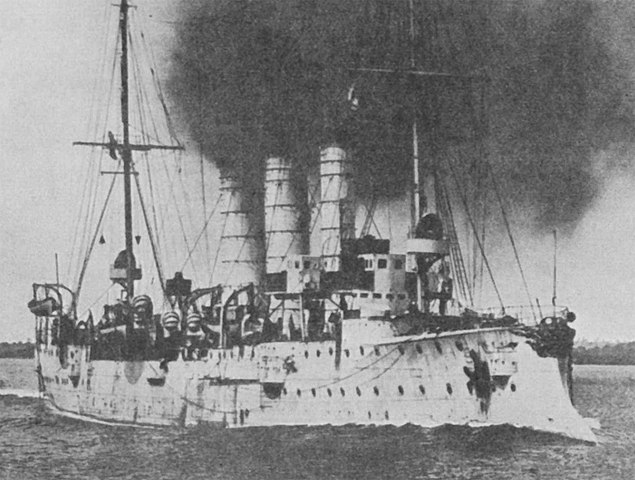
SMS Leipzig underway, prow view
SMS Leipzig was ordered as “N” at AG Weser shipyard (Bremen), laid down on 12 July 1904, launched on 21 March 1905 and fitting out in February 1906, started her builder’s trials. She was armed in Wilhelmshaven to and commissioned on 20 April 1906, making her official sea trials until mid-June 1905 with Fregattenkapitän Franz von Hipper (yes, that one) on command. She also escorted Kaiser Wilhelm II onboard cruise aboard the HAPAG steamer Hamburg for his annual summer cruise.
Peacetime career with the East Asia Squadron
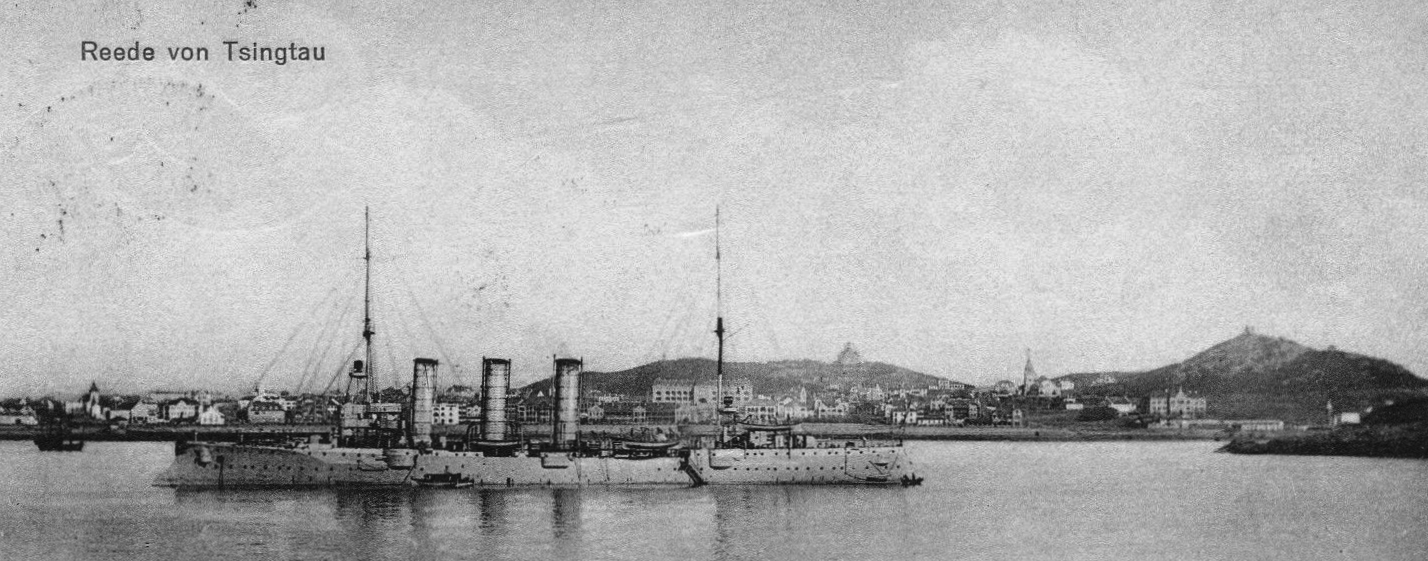
Leipzig in China station Tsingtau
Next, she was assigned to the East Asia Squadron, her crew preparing on 19 August, sailing from Wilhelmshaven on 8 September and went via the Med, Suez canal, Indian Ocean and arrived through the Dutch East Indies, to Hong Kong on 6 January 1907. She joined the protected cruiser Hansa and until 10 March, stayed as guard ship at Tsingtao, Kiautschou Bay. She visited the Yangtze river with Vizeadmiral Carl von Coerper on board and escorted by the gunboat Tiger and torpedo boat S90. In June 1907 she toured with the rest of the squadron northern ports in the region and made another in 1908, in northern East Asian waters followed by a trip in the Yellow Sea thus summer, before greeting her new captain, Richard Engel. In September-October, she visited Shanghai and another voyage in the Yangtze. On 17 November she flew her national flag at the Kobe naval review in Japan, before KK Karl Heuser took command, and was later dry-docked at Hong Kong for maintenance in January 1909.
She was ordered to German Samoa as unrest against German rule was ripe and colonial governor, Wilhelm Solf, requested assistance. For the first time she stopped en route to Manila in the Philippines and later arrived in Apia, capital of German Samoa on 19 March. She was soon joined by SMS Arcona and the gunboat Jaguar, plus the troopship Titania with 100 local police onboard. The local chief were captured and exiled. The ships patrolled off Samoa and in May departed. Leipzig took back Vice Admiral Coerper to Suva (Fiji) on 14-17 May, transferred to another vessel to sail back to Germany while Leipzig returned to Samoa, replaced later by SMS Condor, then steamed to Pago Pago (American Samoa), back to Apia, and headed for Tsingtao, via Pohnpei and Manila, arriving on 29 June. She later trained with the squadron (flagship armored cruiser Scharnhorst).
In early 1910, Leipzig, Scharnhorst and the gunboat Luchs in Hong Kong, cruised in southern waters, visiting Siam and various South China Sea ports like Shanghai and Formosa. FK Hermann Schröder became her new commander and they made a voyage back north via Japan in April-May. Leipzig cruised the Yangtze in July 1910, as far as Hankou to quell unrest. With SMS Gneisenau she went to Calcutta next, in early 1911 meeting Crown Prince Wilhelm touring East Asia, arriving on on 31 January. In March Konteradmiral Günther von Krosigk took command of the squadron and visited Leipzig for his first visit to Japan, meeting there the Emperor Meiji.
Leipzig visited other destinations in Japan and Siberia, and while off Vladimir Bay in mid-August 1910, Captain Schröder learned about tensions with France over Agadir, but the Russians being allied with the latter, they severed telegraph lines and the cruiser only received a garbled wireless message indicating the squadron was to be redeployed to the Indian Ocean. Leipzig wasn sent to Vladivostok, and remained there for confirmation on 15-18 August, exchanging telegraphs with Germany, learning the crisis had passed. The squadron was in the Yellow Sea and made it back to Tsingtao on 15 September.
On 10 October, the 1911 Revolution broke out in China and unrest threatened foreign interests. This prompted Krosigk to deployed the east asia squadron to protect German nationals. Leipzig sent a landing party to reinforce thos from the gunboats Tiger and Vaterland, while Gneisenau was in Nanking, the gunboat Iltis in Hankou. Japanese Rear Admiral Kawashima Reijirō took command of the international forces, combined efforts of various landing parties ashore, evacuating women and children to Shanghai. Leipzig (Krosigk’s flasghip) left Hankou in November due to the low tide in the Yangtze, joining Gneisenau in Shanghai, spending several months patrolling between Tsingtao and trouble ports along the coast, until early August 1912. Next she returned to her training cruise routine, to Vladivostok and Japan, present for the funeral ceremonies of the last Emperor Meiji.
She also was sent in Shanghai and visited cities of central Chinese coast, until in March 1913, her new captain, Johann-Siegfried Haun took command, her final one as was was already looming. The cruiser stayed as an observer as civil war went awhol, with imperial and republican forces clashing around Nanking this summer. She was back to Tsingtao in September, overhauled until October. She sailed south and visited the Philippines, then by May 1914, she relieved the light cruiser Nürnberg by then stationed off the Pacific coast of Mexico, protecting German interests during the Mexican Revolution. She was posted off Mazatlán, on 7 July 1914 together with Dresden and Nürnberg, and the three cruisers sent landing parties to evacuate foreigners. Due to cutout telegraph lines they never learnt of the July Crisis in Europe, and only received news of the war on 31 July. Oddly, just nearby at a few nautical miles, French and Brithsh vessels were also anchored, providing help to their own civilians. Leipzig transferred forty refugees to the then neutral US armored cruiser USS California, then preparations for wartime operations.
With Graf Spee’s Squadron
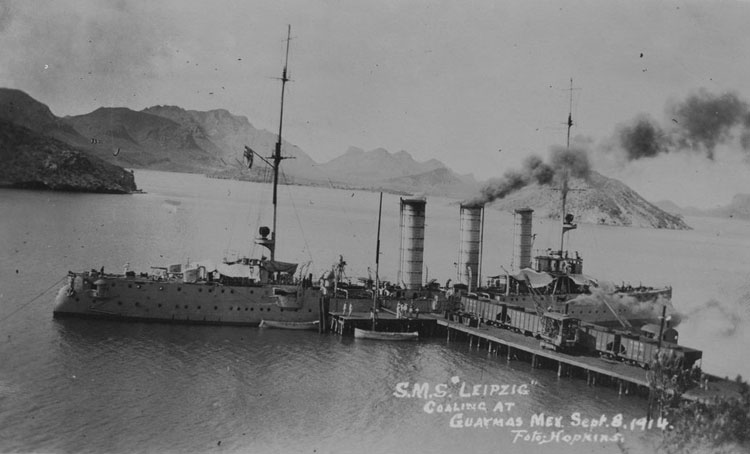
Leipzig coaling off Mexico, Sept. 08, 1914
Leipzig was still Magdalena Bay in Mexico, awaiting orders when they came on 5 August, Captain Haun informing the crew of the state of war between Germany and the Triple Entente, and opened secret instructions in case of war, informing of the gathering of all ships of the East Asia Squadron. Leipzig needed coaling and stopped in San Francisco, but she was unable to fully replenish her bunkers due to US neutrality laws. Haun decided to start a commerce raiding campaign to get his coal from captured allied merchant vessels. Finding none, Haun returned in the Gulf of California on 17 August to get coal, and later sank her first British freighter, carrying sugar underway to the Peruvian coast. She coaled in Guaymas, Mexico, coaling fully on 8 September and on the 10 proceeded south with Naval HQ instructions to stop in the Galápagos Islands where a German merchant vessel was stationed, but but reports of a British squadron there led the ship to diverge course.
After stopping to clean her boiler tubes, burning bad coal until then, she resumed her voyage to Easter Island, arriving on 14 October, joining the rest of the East Asia Squadron under command of Vice Admiral Maximilian von Spee. Leipzig had had gathered three colliers for next operations and departed on 18 October with the rest of the Squadron, heading for South America, stopping in the Juan Fernández Islands and Mas a Fuera, then Valparaiso in Chile, receiving fresh intel about the British cruiser HMS Glasgow present in Coronel. Spee decised to ambush the British ship there, ingoring the presence of the HMS Good Hope and HMS Monmouth, both armoured cruisers.
Leipzig therefore participated in the Battle of Coronel: Leipzig stopped a Chilean barque while off Coronel, searched her and let her go. Leipzig took the head of the squadron. Later on 1 November, she spotted a column of smoke, and later identified three unknown ships, which were Cradock’s squadron. The British in turn spotted Leipzig and both squadron formed into lines of battle. Leipzig was then ordered as the third ship in line, behind the two armored cruisers for protection. At 18:07, each ship was ordered to engage its opposite number and fire broke at 18:34.
This meant Leipzig duelled with HMS Glasgow, but without success due to the range. At 18:49, HMS Glasgow, a recent Town class cruiser was heavier, faster and better armed with two 6-in guns and ten secondaries, and hit Leipzig. The shell however was a dud. Leipzig and Dresden afterwards both targeted Glasgow, hit five times. Spee afterwards ordered Leipzig to close and finish off Good Hope -savaged by the Schanrhost and Gneisenau- with a torpedo, but her approach was marred by a rain squall, and she discovered the ship had already sunk. By 20:00, Leipzig met Dresden in the darkness, which nearly fired on each other, and proceeded back to the Squadron. For this first battle, Leipzig remained essentially unscathed, with not even a wounded crewmen.
Spee afterwards to head for Valparaiso and wait orders. Scharnhorst, Gneisenau, and Nürnberg proceeded into the harbor while Leipzig and Dresden escorted the colliers to Mas a Fuera. The rest of East Asia Squadron at east arrived on 6 November and allcruisers resupplied. On 10 November, Leipzig and Dresden went to Valparaiso in turn and after resupplying, joined the Squadron stationed 250 nautical miles west of Robinson Crusoe Island. They coaled in the Gulf of Penas on 21 November and prepared to to cross the difficult Cape Horn. The British outrage after their defeat of coronel prompting to detach two battlecruisers (HMS Invincible and HMS Inflexible) from their grand fleet, under command of Vice Admiral Sturdee, and clear orders to “search and destroy” Spee’s squadron. Departing on 11 November they were in the Falklands on 7 December, together with the battleship Carnarvon, and the cruisers Kent, Cornwall, Bristol and Glasgow, just repaired.
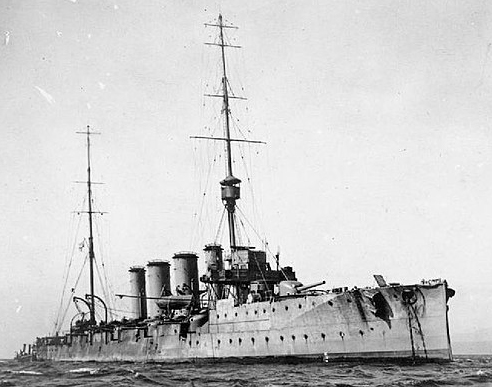
HMS Glasgow
On 26 November, the East Asia Squadron departed Penas and crossed the Cape Horn on 2 December. Leipzig captured the Canadian Drummuir, carrying 2,750 t of coal, transferred to the colliers Baden and Santa Isabel, stationed at Picton Island. On 6 December, Spee held a conference with all his commanders to decide to attack the Falklands, ingoring the presence of the powerful British fleet here. Haun, opposed the plan and proposed to bypassing the Falklands and rampage merchant traffic off La Plata. Spee’s seniority prevailed however, and set the Falklands on 8 December as primary orbjective, a fateful decision.
When approaching Port Stanley, they were spotted, the British ships raising steam, take by Spee as the British were burning their coal stocks. Later he realized there was a powerful British squadron, and decided to broke off and flee, the British in hot pursuit. By 12:55, the battlecruisers, faster, caught up and opened fire on Leipzig, last ship in the German line. Spee at 13:15bravely decided to cover the retreat of hos light cruisers, turning to face the British, five minutes later. Sturdee sent his fast cruisers to chase down Nürnberg, Dresden, and Leipzig however, and the battle developed between the two Scharnhorst and the two Invincible, which turned badly for Hipper.
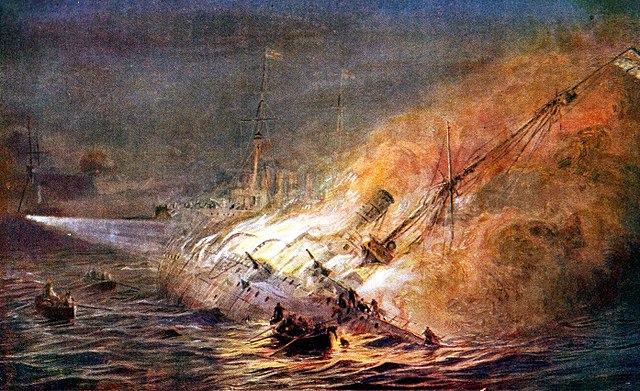
SMS Leipzig sinking
Glasgow chased off Leipzig, her old adversary, and caught up. She opened fire by 14:40 and fired during 20 minutes, hitting Leipzig mutiple times until the latter turned to port to open the range, then starboard to present a full broadside. Both ships pummeled themselves hard, Glasgow eventually breaking off, falling behind the armored cruisers. However Leipzig was now battered by Cornwall and Kent. Soon she was on fire, but went on firing. She hit Cornwall eighteen times and three torpedoes (which failed). At 19:20 however, Leipiz had no guns operational left, all has been knowcked out, her funnels and mast broken, and fires obscured her vision. Haun issued order to scuttle and abandon ship. The British approached nevertheless, opened fire at close range, making a bloody mess on the bridge while crewmen were just trying to evacuate. This did not not stop there as they also engaged even a cutter filled with survivors, destroying it. No quarter was given and no rescue was attempted, but 18 men eventually were later saved from these freezing waters.
Danzig (1905)
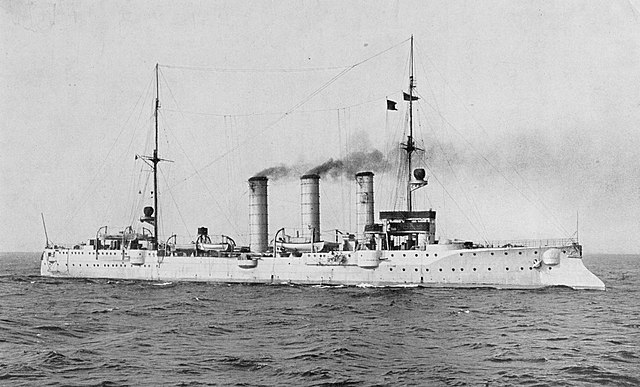
SMS Danzig underway, date unknown
SMS Danzig was ordered as “Ersatz Alexandrine” at the Kaiserliche Werft, Danzig laid down on 12 July 1904, launched on 23 September 1905 (christened by namesake’s Bürgermeister Heinrich Otto Ehlers), followed by fitting-out work, builders trials, armament, official trials with commission on 1 December 1907. Trials ended on 6 April 1908 after which she was assigned the light cruiser Arcona’s crew, assigned to I Scouting Group. Her first voyage was into the central Atlantic this summer, with the battleship squadrons as wanted by Prince Heinrich to break the monotony of German waters training, amidst tensions with Britain. All were back on 13 August, followed by autumn maneuvers (27 August-12 September), Danzig earning the Kaiser’s Schießpreis or Shooting Prize for accuracy excellence in the I Scouting Group. Therefore in 1910, she was used as training ship for the fleet’s gunners.
By August 1914 she was in Brunsbüttel with SMS München, and sailed to Kiel via the Kaiser Wilhelm Canal on the 28th when the British attacked the Heligoland Bight. Both cruisers during the ensuing battle were ordered to steam to the mouth of the Elbe, and proceed to the side, Leipzig arriving where Ariadne just sank, lowering boats to rescue survivors. Konteradmiral Franz von Hipper ordered his cruisers to regroup his cruisers towards the battlecruisers Von der Tann and Moltke, but Fregattenkapitän Reiß refused, to stay and continue the rescue, as for Munchen.
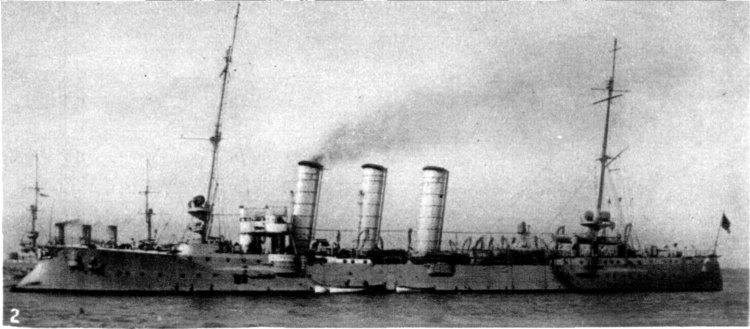
SMS Danzig underway, date unknown
On 7 May 1915, the IV Scouting Group (with Danzig, München, Stettin, and Stuttgart) were ordered to the Baltic, supporting the offensive on Libau under Rear Admiral Hopman. The IV Scouting Group was deployed in a screen to spot and engage a possible Russian naval force from the Gulf of Finland. However when Admiral Makarov, Bayan, Oleg, and Bogatyr arrived and spotted the Germans, the fire exchange was bref until both forces broke off.
Libau was soon captured ans the IV Scouting Group was recalled. On 8 May 1915, Danzig joined the IV Battle Squadron en route to a sweep off Gotland until 10 May. Danzig however ran into a Russian minefield on 25 November 1915, hit one and was towed back to port to be repaired.
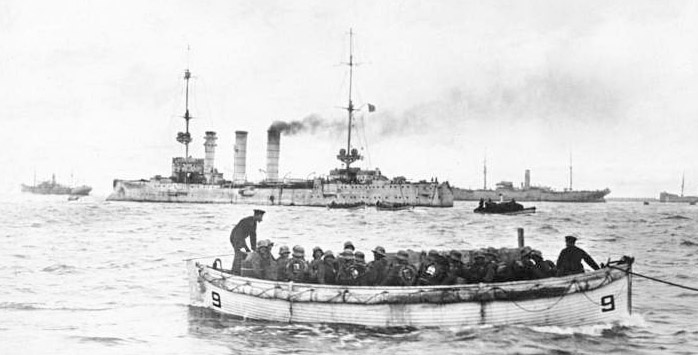
SMS Lepizig during Operation Albion, in cover of the attack on ösel Island
In early September 1917, after the fall of Riga, an operation was planned against the last Russian strongholds in the Gulf. The Navy High Command planned Operation Albion to seize Ösel island, and the gun batteries threatening passage in the Sworbe Peninsula. On 18 September, the joint operation with the army commenced with flagship Moltke leading the the III and IV Battle Squadrons, Danzig being assigned to the II Scouting Group, screening for the invasion force, under command of Prince Adalbert, Kaiser Wilhelm II’s son. On the 19th with Königsberg and Nürnberg she tried to intercept two Russian torpedo boats but could not locate them and broke off.
This was her last significant operation. Outside the routine of training, the cruiser was sidelined due to her age, freeing her crew for other, more modern cruisers, and eventually after inactivity for the remainder of 1915 and 1916, she was withdrawn from active service in late 1917, but only stricken on 5 November 1919. She became British war prize “R’ on 15 September 1920, but the latter decided to have her broken up in Whitby in 1921–1922.



 Latest Facebook Entry -
Latest Facebook Entry -  X(Tweeter) Naval Encyclopedia's deck archive
X(Tweeter) Naval Encyclopedia's deck archive Instagram (@navalencyc)
Instagram (@navalencyc)





 French Navy
French Navy Royal Navy
Royal Navy Russian Navy
Russian Navy Armada Espanola
Armada Espanola Austrian Navy
Austrian Navy K.u.K. Kriegsmarine
K.u.K. Kriegsmarine Dansk Marine
Dansk Marine Nautiko Hellenon
Nautiko Hellenon Koninklije Marine 1870
Koninklije Marine 1870 Marinha do Brasil
Marinha do Brasil Osmanlı Donanması
Osmanlı Donanması Marina Do Peru
Marina Do Peru Marinha do Portugal
Marinha do Portugal Regia Marina 1870
Regia Marina 1870 Nihhon Kaigun 1870
Nihhon Kaigun 1870 Preußische Marine 1870
Preußische Marine 1870 Russkiy Flot 1870
Russkiy Flot 1870 Svenska marinen
Svenska marinen Søværnet
Søværnet Union Navy
Union Navy Confederate Navy
Confederate Navy Armada de Argentina
Armada de Argentina Imperial Chinese Navy
Imperial Chinese Navy Marinha do Portugal
Marinha do Portugal Mexico
Mexico Kaiserliche Marine
Kaiserliche Marine 1898 US Navy
1898 US Navy Sovietskiy Flot
Sovietskiy Flot Royal Canadian Navy
Royal Canadian Navy Royal Australian Navy
Royal Australian Navy RNZN Fleet
RNZN Fleet Chinese Navy 1937
Chinese Navy 1937 Kriegsmarine
Kriegsmarine Chilean Navy
Chilean Navy Danish Navy
Danish Navy Finnish Navy
Finnish Navy Hellenic Navy
Hellenic Navy Polish Navy
Polish Navy Romanian Navy
Romanian Navy Turkish Navy
Turkish Navy Royal Yugoslav Navy
Royal Yugoslav Navy Royal Thai Navy
Royal Thai Navy Minor Navies
Minor Navies Albania
Albania Austria
Austria Belgium
Belgium Columbia
Columbia Costa Rica
Costa Rica Cuba
Cuba Czechoslovakia
Czechoslovakia Dominican Republic
Dominican Republic Haiti
Haiti Hungary
Hungary Honduras
Honduras Estonia
Estonia Iceland
Iceland Eire
Eire Equador
Equador Iran
Iran Iraq
Iraq Latvia
Latvia Liberia
Liberia Lithuania
Lithuania Mandchukuo
Mandchukuo Morocco
Morocco Nicaragua
Nicaragua Persia
Persia San Salvador
San Salvador Sarawak
Sarawak Uruguay
Uruguay Venezuela
Venezuela Zanzibar
Zanzibar Warsaw Pact Navies
Warsaw Pact Navies Bulgaria
Bulgaria Hungary
Hungary

 Bundesmarine
Bundesmarine Dutch Navy
Dutch Navy Hellenic Navy
Hellenic Navy Marina Militare
Marina Militare Yugoslav Navy
Yugoslav Navy Chinese Navy
Chinese Navy Indian Navy
Indian Navy Indonesian Navy
Indonesian Navy JMSDF
JMSDF North Korean Navy
North Korean Navy Pakistani Navy
Pakistani Navy Philippines Navy
Philippines Navy ROKN
ROKN Rep. of Singapore Navy
Rep. of Singapore Navy Taiwanese Navy
Taiwanese Navy IDF Navy
IDF Navy Saudi Navy
Saudi Navy Royal New Zealand Navy
Royal New Zealand Navy Egyptian Navy
Egyptian Navy South African Navy
South African Navy






























 Ukrainian Navy
Ukrainian Navy dbodesign
dbodesign